Neil Diamond | ||
| Allmusic Biography : In a career that began in the 1960s, Neil Diamond became a major recording artist, an internationally successful touring act, and a songwriter whose compositions produced hits for himself and others. His earliest recognition, in fact, came as a songwriter associated with the Brill Building era of Tin Pan Alley in the early 60s. But he soon branched out into recording and performing, and by the early 70s was topping the charts with the self-written singles "Cracklin Rosie" and "Song Sung Blue." This enabled him to be one of the more noticeable figures in the singer/songwriter movement of the period, as he made the transition to an album artist with gold and platinum certifications. He also developed into a dynamic concert performer, as demonstrated on his 1972 album Hot August Night. His millions of fans flocked to his shows and bought his albums in big numbers. Still, as of 2001, he claimed worldwide record sales of 115 million copies, and early in the 21st century, he ranked third, behind only Elton John and Barbra Streisand, on the list of the most successful adult contemporary artists in the history of the Billboard chart. Neil Leslie Diamond was born January 24, 1941 in Brooklyn, New York, the first of two sons born to Akeeba Diamond (known as Kieve), who operated and owned a series of dry goods stores in the New York City borough, and Rose (Rapoport) Diamond. Except for two years in the mid-40s that the family spent in Wyoming while Akeeba Diamond served in the military, Diamond grew up in Brooklyn, albeit in changing locations as his father moved from store to store; he later claimed to have attended nine different schools and to have suffered socially as a result. He showed an early interest in music and took up singing and playing the guitar after seeing Pete Seeger perform at a camp he was attending as a teenager. In June 1958, he graduated from Abraham Lincoln High School, and that fall he enrolled at New York University, where he had won a fencing scholarship, as a pre-med student. But he seems to have spent much of his time writing songs and trying to place them at music publishing companies. He also formed a duo with Jack Packer, a friend of his younger brothers, and as Neil & Jack they signed a publishing contract with Allied Entertainment Corporation of America and a recording contract with its subsidiary, Duel Records. This resulted in the release of two singles, "You Are My Love"/"What Will I Do" in 1960 and "Im Afraid"/"Til Youve Tried Love" in 1961, Diamonds first commercially released recordings. (In 1996, he reissued "What Will I Do" on his box set In My Lifetime.) The discs were not successful, and Neil & Jack broke up when Packer enrolled at the Manhattan School of Music in January 1961. Diamond, meanwhile, had stopped attending NYU in 1960, but in 1961 he enrolled in the universitys School of Commerce, where he maintained his student status until 1965. (Although many accounts of his life repeat the erroneous story that he dropped out of NYU in 1962 just short of earning an undergraduate degree, biographer Rich Wiseman learned the truth by consulting the universitys records.) On his own, Diamond continued trying to break into the music business as a songwriter. In 1962, he briefly had a deal at Sunbeam Music, which published some of his songs, followed by a stint at Roosevelt Music. While he was there, an assignment came in from Dot Records to submit a follow-up to Pat Boones novelty hit "Speedy Gonzales." Ten of the firms writers eventually collaborated on a song, appropriately called "Ten Lonely Guys," which Boone recorded, and which reached number 45 in the Billboard Hot 100 in October 1962. Diamond, one of the ten, was credited under the pseudonym Mark Lewis, but this was his first appearance in the charts. Also in 1962, his composition "Santa Santa" was recorded by the Rocky Fellers and released by Scepter Records. But his next career development involved his own performing. In early 1963, he was signed to a singles deal by Columbia Records, and on January 24, his 22nd birthday, had his first solo recording session, followed by a second session three months later. The results emerged on July 2 as Columbia single 42809, "Clown Town"/"At Night," his first solo release. Unfortunately, the record flopped, and he was dropped by the label. Recently married to schoolteacher Jay Posner (with whom he had two daughters), Diamond kept plugging away, even opening his own tiny office above the jazz club Birdland in midtown Manhattan. In early 1965, his song "Just Another Guy" was recorded in the U.K. by Cliff Richard and placed on the B-side of the number one single "The Minute Youre Gone," released on the British Columbia label. In February 1965, he met the successful writers and producers Jeff Barry and Ellie Greenwich, who took an interest in him and got him signed to songwriter/producers Jerry Leiber and Mike Stollers Trio Music publishing company for three months. This association was over by the time Leiber and Stoller had one of their clients, Jay & the Americans, record "Sunday and Me," a song Diamond had written at Trio. Released as a single in the fall of 1965, the song peaked at number 18 in December, giving him his first real hit as a songwriter. By then, he had made other progress in his career. On June 25, he signed a deal with Barry and Greenwich for publishing and recording, the three forming Tallyrand Music with Diamond as president. (This appears to have prompted his decision finally to drop out of NYU.) Tallyrand shopped both Diamonds songs and Diamond as a recording artist, and on January 6, 1966, it signed a contract with WEB IV, the company controlling the independent Bang Records label. Soon after, Diamond was back in a recording studio, and on April 4, Bang released his label debut single, "Solitary Man," produced, as all his subsequent Bang discs would be, by Barry and Greenwich. "Solitary Man" gave him his first chart entry as a recording artist, peaking at number 55 on the Hot 100 in July. Diamond quickly followed "Solitary Man" with his second Bang single, "Cherry, Cherry," released in July 1966, which gave him his first substantial hit, peaking at number six in October. The singles B-side, "Ill Come Running," was covered by Cliff Richard, who scored a Top 40 hit with it in 1967. When song publisher Don Kirshner heard "Cherry, Cherry," he called Diamond into his office and asked if the songwriter had a similarly upbeat tune that could be used by the Monkees, a group put together for an upcoming TV series. Diamond played him "Im a Believer," a song intended for his debut album. Kirshner liked it, and Diamond, Barry, and Greenwich recorded a backing track that Kirshner took to California and had the Monkees sing over. By the time "Im a Believer" was released as the Monkees second single in the fall of 1966, the group was a teenybopper phenomenon, and the disc had advance orders of over one million copies. It shot to number one, where it stayed seven weeks, becoming the biggest single of 1967. Diamonds debut LP, The Feel of Neil Diamond, released in August 1966, was a rush job, featuring "Cherry, Cherry" and "Solitary Man" along with his covers of hits like "La Bamba" and "Monday, Monday." It barely charted. Also featured, however, was "I Got the Feelin (Oh No No)," an original composition that would be his next single in October. It reached number 16 in December, but the 45 was also significant for its Diamond-penned B-side, "The Boat That I Row." British singer Lulu quickly covered the song, and her version became a Top Ten U.K. hit in the spring of 1967. Diamonds fourth Bang single, "You Got to Me," was released in December 1966 and peaked at number 18 in March 1967. In February, his song "Look Out (Here Comes Tomorrow)" was featured on the Monkees chart-topping second album, More of the Monkees. The following month, "A Little Bit Me, a Little Bit You," the Diamond-penned follow-up to "Im a Believer," entered the singles chart for the Monkees; it peaked at number two in April. Also in March, Bang released its fifth Diamond single, "Girl, Youll Be a Woman Soon," which became his second Top Ten hit in May. In April, Ronnie Dove entered the charts with "My Babe," written and produced for him by Diamond; it peaked at number 50 in May. Bangs sixth Diamond single, "Thank the Lord for the Night Time," appeared in June, peaking at number 13 in August. That month saw the release of Diamonds second LP, Just for You, which peaked at number 80. Diamonds sixth Bang single, "Kentucky Woman," followed in September, and it reached number 22 in November, giving him his sixth consecutive Top 40 hit. After nearly two years of hit recording and songwriting, Diamond had a falling-out with his producers and his record label. As popular music turned more serious in the late 60s, he became less satisfied writing simple pop songs, and, instead of "Kentucky Woman," he had proposed that his sixth Bang single be "Shilo," an introspective ballad not about the Civil War battle, but about an imaginary childhood friend, that he had written and recorded. Bang, thinking the song less commercial than "Kentucky Woman," used it as an LP track on Just for You instead, and Diamond, who was also dissatisfied with his royalties, found a loophole in his contract, which, it turned out, failed to bind him exclusively to WEB IV and Tallyrand. He therefore declared himself free to sign a recording contract with another company. Soon, lawsuits were flying. On March 12, 1968, a judge denied WEB IVs request for a temporary injunction preventing Diamond from signing to another record label while his contract dispute was making its way through the courts. It was a key decision; the lawsuits would continue for another nine years until Diamond settled them on February 18, 1977, when he purchased his Bang master recordings. But on March 18, 1968, he signed a five-year contract with Uni Records, a division of MCA. The first product of the deal was another introspective, autobiographical ballad, "Brooklyn Roads," released in April. Diamond followed with the more uptempo "Two-Bit Manchild" that month, but neither that single nor its follow-up, "Sunday Sun," which appeared in September, restored him to the Top 40, and Velvet Gloves and Spit, Diamonds debut album for Uni, failed to chart. Meanwhile, there was more upheaval in his life. Now romantically involved with TV production assistant Marcia Kay Murphey, he left his wife and moved to California. After their divorce was final in November 1969, he married Murphey one month later. Professionally, Diamond tried to stem the tide of his career decline by recording at American Sound Studio in Memphis, beginning on January 8, 1969. Working with producers Tommy Cogbill and Chips Moman, he took more of a gospel-tinged, country-rock approach, starting with the single "Brother Loves Travelling Salvation Show," quickly released as a single, which peaked at number 22 in April, his best chart showing in 18 months. He quickly returned to Memphis and cut an album also called Brother Loves Travelling Salvation Show that was released in April and peaked at number 82. The song that finally sealed Diamonds commercial comeback was his next single, "Sweet Caroline (Good Times Never Seemed So Good)," a catchy tune that peaked at number four in August, the same month it earned a gold record certification for sales of one million singles. Diamond followed "Sweet Caroline" with the gospel-tinged "Holly Holy," released in October 1969, and scored another big hit, the track peaking at number six in December. It was his second gold (and eventually platinum) single, and the song earned a cover by Junior Walker & the All-Stars that made the R&B; Top 40 in 1971. The Diamond recording was included on his fifth LP, Touching You Touching Me, released in November 1969; the disc was his most successful so far, peaking at number 30 and going gold in a little over a year. Meanwhile, Diamonds career resurgence was not going unnoticed at his former label, Bang Records, which hired American Sound Studio musicians to record a new musical track for "Shilo" under Diamonds vocal. With a sound more like his current records, the single reached number 24 in April 1970. Diamond responded by returning to Memphis himself and cutting a new recording of "Shilo," which was added to later editions of Velvet Gloves and Spit. A more ambitious effort was "Soolaimón (African Trilogy II)," released in April, an excerpt from the side-long "folk ballet" of African-styled songs to be featured on his next album, Tap Root Manuscript, in the fall. The single reached number 30 in May. Diamonds next new single, "Cracklin Rosie" (famously referring to the cheap wine Cracklin Rosé), appeared in July and became his biggest hit yet, topping the charts in October. Also released in July 1970 was the live album Gold, which had been recorded in March at the Troubadour nightclub in Los Angeles. Another major commercial success, it peaked at number ten in September. As the result of "Cracklin Rosie" and Gold, by the fall of 1970 Diamond had graduated to the theater and arena circuit as a live act. For his next single, he made the odd choice of releasing a cover of "He Aint Heavy, Hes My Brother," a song that had been a Top Ten hit for the Hollies the previous spring. Competing with Bangs release of the former B-side "Do It," it still managed to peak at number 20 in December and, along with "Soolaimón" and "Cracklin Rosie," served as a good calling card for Tap Root Manuscript, which appeared in November. Consistent with Diamonds current status, the album peaked at number 13. Reportedly, Diamond worked months on the lyric of his next single, the autobiographical "I Am...I Said," released in March 1971. An impassioned statement of emotional turmoil, the song was very much in tune with the confessional singer/songwriter movement of the time, and it became a major hit, peaking at number four in May, with even its B-side, "Done Too Soon" (previously released on Tap Root Manuscript), earning a chart placing. "I Am...I Said" earned Diamond his first Grammy nomination, for Best Pop Vocal Performance, Male. Diamond returned to the record racks in the fall with the ballad "Stones," released in October, followed by an album of the same name in November. The single reached number 14, while the LP stopped just short of the Top Ten and went gold in two months. Diamonds next album, Moods, was prefaced by another of his standards. "Song Sung Blue," released in April 1972, became his second number one hit on the Hot 100 in July, also becoming his fourth gold single and earning Grammy nominations for Record of the Year and Song of the Year. In August, Diamond performed ten shows at the Greek Theatre in Los Angeles, recording them for a live album. The double-LP set Hot August Night, which appeared in November, cemented his status as a concert attraction by hitting number five and going gold in a month. (It was later certified double platinum.) A single of "Cherry, Cherry" was excerpted from the release and made number 31. Hot August Night marked Diamonds ascension to superstar status, and it also marked the end of a phase of his career. After three weeks of shows at the Winter Garden on Broadway in October, he temporarily retired from live performing. At the same time, he had completed his recording contract, and he signed a new, lucrative one with Columbia Records. His first project for the new label was a song score for the film version of the best-selling novel Jonathan Livingston Seagull. It was a troubled project, and by the time the movie was released in October 1973, both Diamond and Richard Bach, the books author, were suing the film producer. Reviews were awful, and the picture bombed. But Diamonds score, released as a solo album by him, was a hit. The single "Be" only grazed the Top 40, yet the LP reached number two in December. It also won Diamond the 1973 Grammy Award for Best Album of Original Score Written for a Motion Picture or TV Special. Even after completing Jonathan Livingston Seagull, Diamond continued to stay off the road. He was next heard from in the fall of 1974, when he released his first regular album for Columbia, Serenade, prefaced by the single "Longfellow Serenade," which was his biggest hit since "Song Sung Blue," peaking at number five on the Hot 100 and number one on the AC chart in November. Serenade hit number three in December, another instant gold album that has since gone platinum. Another year went by before Diamond finally returned to live work, doing a few shakedown shows in California and Utah in late January and early February 1976 before launching a tour of Australia and New Zealand, followed by more dates in the U.S. in the spring. Meanwhile, working with Malibu neighbor Robbie Robertson of the Band as his producer, he had finished a new album, Beautiful Noise, its songs reflecting back on his early-60s days in Tin Pan Alley. Leadoff single "If You Know What I Mean," issued in June, reached number 11 on the Hot 100, and the album, which followed a couple of weeks later, hit number four. On July 1, 1976, for a hefty fee, Diamond made his Las Vegas debut at the Aladdin Hotel, though he would avoid the entertainment mecca afterward until well into the 90s. In September, he returned to the Greek Theatre in Los Angeles, this time with both cameras and recording equipment in tow. On November 25, 1976, he appeared as one of the special guests at the Bands farewell concert at Winterland in San Francisco, performing the Beautiful Noise track "Dry Your Eyes," which he had co-written with Robertson. The show was filmed and recorded for the 1978 movie and triple-LP set The Last Waltz. Both of Diamonds albums of 1977 were associated with television specials. First came Love at the Greek, like Hot August Night a two-LP concert set drawn from shows at the Greek Theatre. It appeared in February 1977, two weeks ahead of The Neil Diamond Special, broadcast February 21. The LP reached number eight in April, selling a million copies by July, with another million registered since. Diamond undertook a lengthy tour of Europe in the spring and summer. In November, Diamond was back with a new studio album, Im Glad Youre Here with Me Tonight, again tied into a TV special. The simultaneously released single "Desirée" went Top 20, while the album reached number six in February 1978, racking up the usual sales number of a million copies with another million to come. One of the album tracks for Im Glad Youre Here with Me Tonight was a sad breakup ballad called "You Dont Bring Me Flowers" that Diamond had written for a television pilot about reversed sex roles (hence the novelty of having a man complain about romantic neglect in terms usually used by a woman). Labelmate Barbra Streisand knew a big ballad when she heard one, especially one co-written by her personal lyricists, Alan and Marilyn Bergman, and she quickly covered the song, which appeared on her Songbird album in May 1978. A disc jockey, realizing that both Diamonds and Streisands versions were in the same key, spliced them together, and began playing the duet he had created on the air, leading to requests for a record. On October 17, 1978, that desire was satisfied, as the two singers cut a new recording of the song. Credited to "Barbra & Neil," the single was quickly released and soared to number one on the pop charts, eventually earning a platinum certification. Diamond had been working on an album to be titled after a tune called "The American Popular Song," written by his pianist, Tom Hensley; the LP was to be a collection of covers. The unexpected success of the duet upset these plans, however, and Diamond quickly cobbled together an album for release under the title You Dont Bring Me Flowers, which appeared in November. By the end of January, it peaked at number four, having been certified platinum, with a double platinum award to follow. In February, Columbia released another single from it, the uptempo "Forever in Blue Jeans" (co-written by Richard Bennett), which reached the Top 20. Diamond collaborated with French singer/songwriter Gilbert Bécaud on the title track of his next album, September Morn, released in December 1979. The single reached the Top 20 of the pop chart, and the album peaked at number ten in February 1980. Any thought that Diamonds popularity might be cooling, however, was belied by his next project. Almost without acting experience, he had nevertheless agreed to star in a second screen remake of The Jazz Singer. The response was very similar to what had greeted Jonathan Livingston Seagull seven years earlier, except that this time Diamond was actually in the picture. Upon release in December 1980, it was panned by critics and became a box office failure. But the Capitol soundtrack album, consisting of a Diamond-written and performed song score, was a remarkable hit. "Love on the Rocks" (co-written with Bécaud) came out in advance of the LP, and it peaked at number two in January 1981. By February, the album was up to number three, having already sold a million copies. "Hello Again" (co-written by Alan Lindgren of Diamonds band), the second single, reached number six in March, and the anthemic "America" peaked at number eight (number one AC) in June as the album kept selling. (Eventually, it was certified for sales of five million copies, making it Diamonds most successful LP. It earned him another Grammy nomination in the category of Best Album of Original Score Written for a Motion Picture or TV Special.) Diamond picked a good time to reach a career peak: his record contract was up for renewal, and he re-signed to Columbia in October 1981 committing himself to ten more albums at a guarantee of $30 million dollars. It was, briefly, the most lucrative record contract in history. At the same time, of course, he had a new Columbia album ready, On the Way to the Sky, advanced by the single "Yesterdays Songs," which topped the AC chart and reached number 11 in the pop chart. The album, however, became his first in ten years to miss the Top Ten, peaking at number 17. The title track, co-written with Carole Bayer Sager, failed to chart as a 45, but a third single, "Be Mine Tonight," made the Top 40. Having worked with Bayer Sager, Diamond now turned to collaborating with both her and her then-husband, Burt Bacharach, a fellow graduate of the Brill Building era, on his next album, Heartlight. The title song, written by the three and inspired by the recently released movie E.T.: The Extra-Terrestrial, emerged in August 1982 as a single that hit number one in the AC chart and returned Diamond to the pop Top Ten, peaking at number five in November. Diamond was relatively inactive on the performing front in 1983, though he did undertake a weeklong series of shows at the Forum in Los Angeles in June, his first L.A. shows in six years. He was, of course, writing, again collaborating with Bacharach and Bayer Sager, and recording, and on February 6, 1984, he submitted a new album to Columbia. The label asked him to make changes but, citing the artistic control mandated in his contract, he sued to have the LP released as it was. In April, however, he withdrew his suit and revised the disc to the record companys requirements. After completing the new version, he accepted a $500,000 fee for performing three shows at Harrahs Trump Plaza in Atlantic City, New Jersey in June, then undertook a European tour, followed by an American tour. Columbia released the new album, Primitive, in July, along with the first single, "Turn Around" (co-written by Diamond, Bacharach, and Bayer Sager). Notwithstanding the labels attempt to enhance the commerciality of the disc, it was a disappointing seller. "Turn Around" lodged in the AC Top Ten, but missed the pop Top 40, and Primitive peaked at number 35 and only went gold, the worst showing for a new Neil Diamond album since 1969. Diamond reacted by working up what was intended to be one of his most personal albums, as indicated by its proposed title, The Story of My Life. He submitted the collection to Columbia in September 1985, and for the second time in a row had an album rejected by the label. This time, he did not protest publicly. Instead, he accepted Columbias suggestions that he try to take a more contemporary approach by, for example, working with Maurice White of Earth, Wind & Fire, recording a song written by currently popular rocker Bryan Adams, and using such guest stars as Stevie Wonder (who also co-wrote a song). Eventually, every song on the album except the former title track, "The Story of My Life," was replaced. To further promote the upcoming release, now titled Headed for the Future, in January 1986 Diamond taped a new television special, Hello Again, for CBS, then the parent company of Columbia Records. The special was broadcast May 25, two-and-a-half weeks after the release of Headed for the Future, which itself had been prefaced by the release of the title song (written by Diamond, Hensley, and Lindgren) as a single in late April. The effort to modernize Diamond succeeded only slightly. The album peaked at number 20, an improvement over Primitive, but like its predecessor, the album only went gold. The single missed the Top 40, and a second single, "The Story of My Life," got to only number 11 AC. But if his record sales were disappointing, Diamonds concert tours remained SRO. An eight-night stand at Madison Square Garden in New York was followed by 14 shows back at the Greek Theatre in August, commemorated by Columbia with another double-LP live album, Hot August Night II, released in October 1987. The album, however, peaked at a disappointing number 59 and didnt even go gold at first (though it has since gone platinum). (Appended was a studio recording of "I Dreamed a Dream" from the musical Les Misérables, which got to number 13 on the AC chart.) Diamonds main collaborator for his next studio album, The Best Years of Our Lives, was David Foster, who produced it and co-wrote several of the tracks. Released in December 1988 to coincide with an HBO special, the album peaked at number 46 and went gold, with three of its tracks making the AC chart. Much the same response greeted Diamonds next studio album, Lovescape, produced by Peter Asher (the famed producer of James Taylor and Linda Ronstadt, who began to work with Diamond regularly), when it appeared in August 1991. It peaked at number 44 and spawned three AC chart entries, while taking almost three years to go gold. Meanwhile, however, Diamond remained a major force on the concert circuit, taking his Love in the Round tour around the country and around the world. In 1992, for example, he was said to be the second-highest grossing American concert act of the year. In September 1992, Diamond released his first seasonal collection, The Christmas Album, and promoted it with Neil Diamonds Christmas Special on HBO. In January 1993, Diamond again re-signed to Columbia for an additional six albums. The first of these, released in September, was Up on the Roof: Songs from the Brill Building, his treatments of early-60s evergreens like the title song and "Youve Lost That Lovin Feelin." It hit number 28 and went gold. Meanwhile, the singer continued to tour extensively, his grosses for the year exceeded only by U2. That success was reflected by yet another chart-bound concert recording, Live in America, a double CD issued in June 1994. The fall brought The Christmas Album, Vol. 2, only two years after its successful predecessor. Also in the fall of 1994, Diamond participated in the Frank Sinatra album Duets II, singing "The House I Live In" with the venerable star. During 1995, Diamond finally got to work on an album of newly written material, but there was a twist. The man whose songs had sometimes been turned into country hits went to Nashville and held songwriting sessions with country writers, also recording with country stars. The result was Tennessee Moon, released in February 1996, along with a TV special, Under a Tennessee Moon, broadcast on ABC. The album peaked at number three in the country charts and number 14 in the pop charts and went gold. Diamond continued to make events out of his album releases. In October 1998, he issued The Movie Album: As Time Goes By, a two-disc collection of covers of movie songs like "Moon River" and "Unchained Melody." It reached number 31 and went gold, earning a Grammy nomination for Best Traditional Pop Vocal Performance. As usual, Diamond embarked on a world tour to support it. And as usual, his fans came out. Even during a decade when he retreated from the front line of recording artists, the singers live following, if anything, increased. He was named the top solo concert artist of the 90s by Amusement Business magazine. In 2001, Diamond finally wrote and recorded a new studio album, Three Chord Opera, released in July. In fact, he did all the writing entirely by himself, the first time he hadnt collaborated with anyone since Serenade in 1974. In 2004, he began working with renowned producer Rick Rubin, a longtime fan who had produced Johnny Cashs 90s comeback albums. Before releasing the result of their collaboration, the 2005 album 12 Songs, he embarked on another world tour. 12 Songs was issued on November 8, 2005, to a chorus of positive reviews. It entered the chart at number four, Diamonds highest chart placing in 25 years. In 2006, Diamond made another movie cameo, singing "Hava Nagilah" in the film comedy Keeping Up with the Steins, and he returned to the recording studio with producer Rubin for 2008s Home Before Dark. A holiday release, A Cherry Cherry Christmas, appeared in 2009, and in 2010 Diamond released Dreams, a covers collection featuring songs by some of his favorite songwriters of the rock and soul era. In 2011 he was inducted into the Rock and Roll Hall of Fame at a ceremony in New York City and by the end of summer 2012 he had received a star on the Hollywood Walk of Fame. Prestigious television appearances ensued in the form of a headline slot on December 2012s centenary edition of the U.K.s Royal Variety Performance, before Independence Day 2013 found Diamond on a bill at the U.S. Capitols A Capitol Fourth concert. After a 40-year relationship with Columbia Records, it was reported in January 2014 that he had signed a recording contract with Capitol. This resulted in the whole of Diamonds catalog -- incorporating his MCA, Columbia, and Bang material -- being assembled under the umbrella of Universal Music Group, Capitols owners. The bigger news was the announcement of Melody Road, his first album for Capitol. Produced by Don Was and Jacknife Lee, the album appeared in October 2014 and debuted at three on Billboards Top 200. Diamond reunited with the pair of Was and Lee for 2016s holiday album Acoustic Christmas. Early in 2017, Diamond celebrated the 50th anniversary of his first hit by releasing the triple-disc compilation 50 and launching a massive world tour. Latter portions of this same tour were later cancelled after Diamond revealed in January 2018 that he had been diagnosed with Parkinsons Disease and would be retiring from live performing. The live album, Hot August Night III, captured in 2012 at Los Angeles Greek Theatre, was released in September of that year. | ||
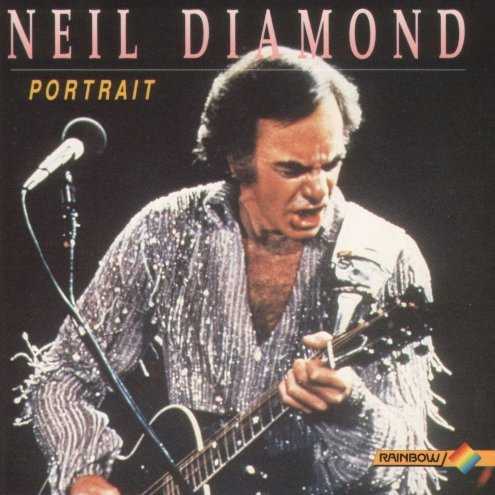 | Album: 1 of 48 Title: Portrait Released: Tracks: 12 Duration: 37:25 Scroll: Up Down Top Bottom 25% 50% 75% AlbumCover | 1 Cracklin Rosie (03:00) 2 New York Boy (02:38) 3 Sunday Sun (02:47) 4 And the Grass Wont Pay No Mind (03:33) 5 Free Life (03:10) 6 Thank the Lord for the Nightime (03:03) 7 Sweet Caroline (Good Times Never Seemed So Good) (03:22) 8 Mr. Bojangles (04:52) 9 Merry-Go-Round (03:30) 10 Chelsea Morning (02:32) 11 Honey Drippin Times (02:01) 12 Juliet (02:53) |
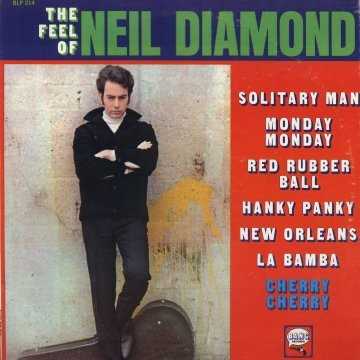 | Album: 2 of 48 Title: The Feel of Neil Diamond Released: 1966 Tracks: 12 Duration: 29:38 Scroll: Up Down Top Bottom 25% 50% 75% Allmusic Wikipedia AlbumCover | 1 Solitary Man (02:33) 2 Red Rubber Ball (02:19) 3 La Bamba (02:07) 4 Do It (01:57) 5 Hanky Panky (02:47) 6 Monday, Monday (03:03) 7 New Orleans (02:24) 8 Someday Baby (02:17) 9 I Got the Feelin (Oh No, No) (02:19) 10 Ill Come Running (02:50) 11 Love to Love (02:20) 12 Cherry, Cherry (02:42) |
| The Feel of Neil Diamond : Allmusic album Review : Neil Diamonds debut LP was issued in October 1966 just as "Cherry Cherry" -- Diamonds first Top Ten hit -- was peaking at number six on the singles chart. Its a fascinating document, and not just in hindsight: it has virtues of its own, separate from being an early chapter in a long career to follow. As a showcase for Diamond as both singer and songwriter, he fares well in both capacities, though his songwriting is more interesting here than his singing, but thats no surprise, as according to his own account, hed just achieved a new level of seriousness and depth as a composer and was reveling in the best that he could do at that moment. As a singer, he needed more time to develop, though he obviously had a good deal of depth and expressiveness at his command, even in 1966. He does have some wonderfully transcendent moments here, and not just on the hits -- "Solitary Man," "Cherry Cherry," and "Oh No No (Ive Got The Feeling)" are familiar to most fans -- but "Love to Love," "Someday Baby," etc. also show some of the power and range that Diamond would be able to muster more effectively in his singing as he moved toward his prime years, and show the new, very personal songwriting he was pursuing. Hes at his best on the original songs, the most personal of which (apart from "Solitary Man") are confined to the second side of the album: producers Jeff Barry and Ellie Greenwich (who are all over this record with handclaps, backing vocals etc.) wanted to introduce his talent to the would-be purchasers gradually, book-ending the contents between the two hits ("Oh No No" didnt chart until a month after the LPs release) and offering Diamond doing a handful of covers of familiar hits. Given that he was still making the transition from songwriter to performer, he does very well by all of the latter, which include Paul Simon‘s "Red Rubber Ball" (done in the same arrangement used by the Cyrkle, but with Diamonds raw, personal singing a very different experience from that groups harmonies) and John Phillips‘ "Monday Monday" (with Ellie Greenwich very prominent on the vocals), as well as the Barry-Greenwich "Hanky Panky." As a debut effort, it has some flaws that one would expect; not all of Diamonds originals were jewels, and he would find some finer nuances to his singing in short order. But when his songwriting and singing were on target, which was well over half the album, this was one of the better pop/rock releases of 1966, as well as a kind of transitional work in a singer/songwriter mold. It sounds (and even often, on the covers, feels) like Brill Building pop, but the words and the singing are already evolving out of those origins and into something new. | ||
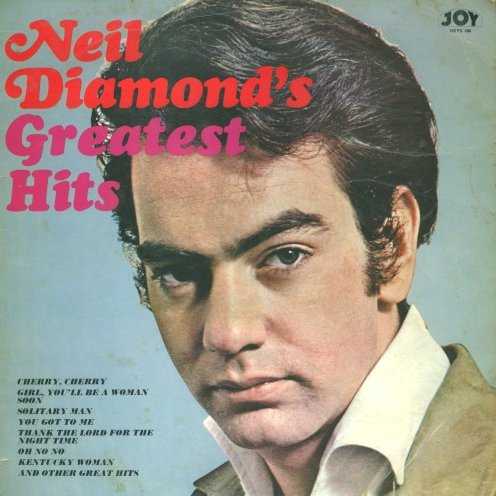 | Album: 3 of 48 Title: Neil Diamond’s “Greatest Hits” Released: 1967 Tracks: 12 Duration: 31:17 Scroll: Up Down Top Bottom 25% 50% 75% Allmusic AlbumCover | 1 Cherry, Cherry (02:42) 2 Oh No No (02:13) 3 New Orleans (02:28) 4 Girl, Youll Be a Woman Soon (02:58) 5 Do It (01:54) 6 You Got to Me (02:48) 7 Solitary Man (02:33) 8 Kentucky Woman (02:26) 9 Thank the Lord for the Night Time (03:01) 10 Red Red Wine (02:39) 11 Hanky Panky (02:51) 12 The Boat That I Row (02:44) |
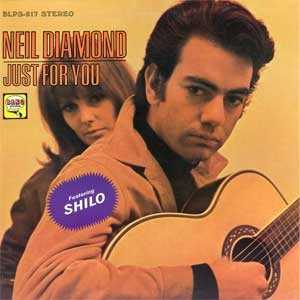 | Album: 4 of 48 Title: Just for You Released: 1967 Tracks: 11 Duration: 30:15 Scroll: Up Down Top Bottom 25% 50% 75% Allmusic Wikipedia AlbumCover | 1 Girl, Youll Be a Woman Soon (02:48) 2 Long Way Home (02:29) 3 Red, Red Wine (02:41) 4 Youll Forget (02:51) 5 The Boat That I Row (02:40) 6 Cherry, Cherry (02:27) 7 Im a Believer (02:43) 8 Shilo (03:23) 9 You Got to Me (02:45) 10 Solitary Man (02:33) 11 Thank the Lord for the Night Time (02:55) |
| Just for You : Allmusic album Review : Neil Diamond was on the cusp of discovering a new genre with his second album, which perfectly straddled early- and mid-60s Brill Building teen pop and the as-yet-unidentified (and unnamed) singer/songwriter genre. The production is as smooth and crisp (and solidly commercial) as anything ever to come from the renowned hit factory at 49th and Broadway by way of the Monkees, Little Eva, the Raindrops, et al. But unlike his debut LP, this time out every song (including two carried over from his debut) is a Diamond original, and his voice and delivery are a lot more sophisticated -- on "The Long Way Home," "Red, Red Wine," etc., he sounds like hes living the lyrics, but in a more personal manner than, say, Tom Jones or Engelbert Humperdinck -- and as they are Diamonds lyrics, the effect is natural rather than any performing artifice. Some of the slickness obviously flattens out what might have been some more personal edges to the songs: it would have been (and still would be) interesting to hear Diamond take the best of these songs and reinterpret them in the studio later in his career, when he had more to say and more control over how they were treated. And to be fair, a few, such as "Youll Forget," are a bit on the generic and trivial side (but are still eminently listenable, and solid pop/rock). Oddly enough, Diamonds then-current big hit "Kentucky Woman" isnt present here, though a pair of successes from the previous year, "Cherry Cherry" and "Solitary Man" (probably getting a second go-round because its serious emotions fit in this setting better than they did on the debut album), are aboard. But somewhat eclipsing them and everything else here, for the attentive listener, is a song and a performance that show Diamond rising to a new level as a musician and composer: "Shilo." His most personal song of this era, it represented the opening of a new chapter in his career, but one that Bang Records chief Bert Berns was unwilling to turn the page to open, as he believed the company was better served by keeping Diamond identified with catchy pop/rock aimed at teenagers 16 and under, not deeply personal, confessional lyrics that might not appeal to them. Berns refusal to release the song as a single led to a rift between Diamond and the label which, following Berns death from a heart attack at the end of 1967, ended the singers relationship with the company. Listening to the song tucked neatly into the middle of side two of this album, it still sounds like it exists on a whole different plane from anything else here. It was a deal-ender between Diamond and Bang, but also a career-maker in terms of getting him to a place where he could advance to his full potential. | ||
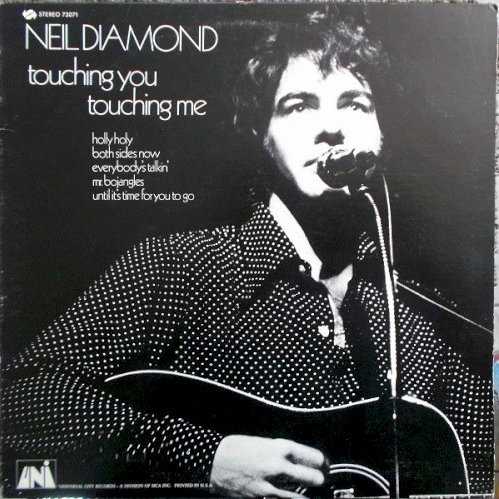 | Album: 5 of 48 Title: Touching You, Touching Me Released: 1969 Tracks: 9 Duration: 30:50 Scroll: Up Down Top Bottom 25% 50% 75% Spotify Allmusic Wikipedia AlbumCover | 1 Everybody’s Talkin’ (02:39) 2 Mr. Bojangles (04:52) 3 Smokey Lady (02:40) 4 Holly Holy (04:40) 5 Both Sides Now (03:31) 6 And the Singer Sings His Song (03:37) 7 Ain’t No Way (02:42) 8 New York Boy (02:38) 9 Until It’s Time for You to Go (03:31) |
| Touching You, Touching Me : Allmusic album Review : Diamonds first regular album release to sell in substantial numbers, Touching You, Touching Me contains the gold Top Ten single "Holly Holy," and a Diamond composition, but is mostly notable for its covers of standards by other songwriters: "Everybodys Talkin," "Mr. Bojangles," "Both Sides Now," and the chart entry "Until Its Time for You to Go." These helped signal that Diamond was thinking of himself less as a Brill Building hack than as a peer of Fred Neil, Jerry Jeff Walker, Joni Mitchell, and Buffy Sainte-Marie. | ||
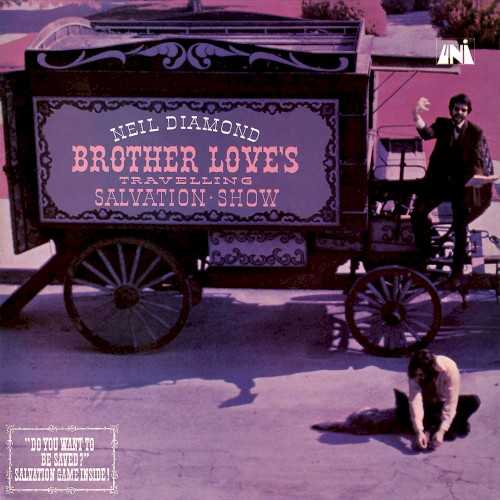 | Album: 6 of 48 Title: Brother Love’s Traveling Salvation Show Released: 1969-04 Tracks: 12 Duration: 36:04 Scroll: Up Down Top Bottom 25% 50% 75% Allmusic AlbumCover | 1 Brother Love’s Traveling Salvation Show (03:29) 2 Dig In (02:41) 3 River Runs, New Grown Plums (01:58) 4 Juliet (02:54) 5 Long Gone (03:18) 6 And the Grass Won’t Pay No Mind (03:33) 7 Glory Road (03:19) 8 Deep in the Morning (03:07) 9 If I Never Knew Your Name (03:18) 10 Memphis Streets (02:41) 11 Youre So Sweet, Horseflies Keep Hangin’ Round Your Face (03:13) 12 Hurtin’ You Don’t Come Easy (02:32) |
| Brother Love’s Traveling Salvation Show : Allmusic album Review : Neil Diamonds second album for Uni offered the typical strengths and weaknesses of his LPs for the label. The strengths? A good single (the title track) and a rather remarkable stylistic diversity. The weaknesses? The failure of any of the other tracks to stand out nearly as much as the single, and the feeling that sometimes Diamond was doing something just to prove he could do it, without the quality material to justify the experimentation. Although taken by itself almost any track sounds normal, running all together the record sounds kind of weird. Theres a rather respectable Dion-esque bluesy groove on "Dig In" (cool stuttering organ on this one); "River Runs, New Grown Plums" has the stop-start rhythm and crisp AM production of earlier singles like "Kentucky Woman," but isnt as strong a tune. Less impressively, "Long Gone" is tinged with country-rock; "And the Grass Wont Pay No Mind" and "Juliet" are above-average MOR pop; "Hurtin You Dont Come Easy" is introspective singer/songwriting; and "Youre So Sweet Horseflies Keep Hangin Round Your Face" is dumb country satire. At other points, it just sounds like his late-60s singles, without being strong enough to justify inclusion on a 45. The album was improved considerably when the hit "Sweet Caroline" was added after its initial release, and the title changed to Sweet Caroline: Brother Loves Traveling Salvation Show. | ||
 | Album: 7 of 48 Title: Greatest Hits Released: 1970 Tracks: 12 Duration: 31:20 Scroll: Up Down Top Bottom 25% 50% 75% Spotify Allmusic AlbumCover | 1 Im a Believer (02:48) 2 Some Day Baby (02:20) 3 The Boat That I Row (02:50) 4 Love to Love (02:20) 5 New Orleans (02:25) 6 Solitary Man (02:35) 7 Do It (02:50) 8 The Long Way Home (02:30) 9 Youll Forget (02:50) 10 Shot Down (02:36) 11 Crooked Street (02:26) 12 Hanky Panky (02:50) |
 | Album: 8 of 48 Title: Tap Root Manuscript Released: 1970 Tracks: 12 Duration: 35:54 Scroll: Up Down Top Bottom 25% 50% 75% Spotify Wikipedia Allmusic AlbumCover | 1 Cracklin’ Rosie (02:59) 2 Free Life (03:11) 3 Coldwater Morning (03:21) 4 Done Too Soon (02:41) 5 He Ain’t Heavy, He’s My Brother (04:11) 6 Childsong (02:11) 7 I Am the Lion (02:08) 8 Madrigál (01:54) 9 Soolaimòn (04:33) 10 Missa (02:07) 11 African Trilogy (04:30) 12 Childsong (reprise) (02:04) |
| Tap Root Manuscript : Allmusic album Review : The follow-up to Touching You, Touching Me was an ambitious set of songs, all originals except for a Top 20 cover of "He Aint Heavy...Hes My Brother," including the side-long suite "The African Trilogy" (which featured the hit "Soolaimon"), the number one hit "Cracklin Rosie," and "Done Too Soon." Going gold within two months, this album confirmed Diamonds breakthrough as a recording star. | ||
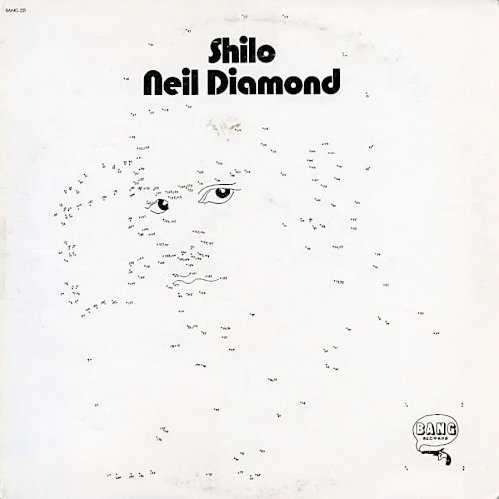 | Album: 9 of 48 Title: Shilo Released: 1970 Tracks: 12 Duration: 34:16 Scroll: Up Down Top Bottom 25% 50% 75% Allmusic AlbumCover | 1 Shilo (03:52) 2 Kentucky Woman (02:26) 3 Girl Youll Be a Woman Soon (02:59) 4 You Got to Me (02:48) 5 Monday, Monday (02:49) 6 Cherry, Cherry (live) (03:06) 7 Solitary Man (02:37) 8 Im a Believer (02:38) 9 Red, Red Wine (02:41) 10 Thank the Lord for the Night Time (03:01) 11 Ill Come Running (03:04) 12 Oh, No, No (02:15) |
| Shilo : Allmusic album Review : Shilo is a hits compilation covering Neil Diamonds Bang years, from his first hit, "Solitary Man," to the title track, which was issued in 1970 to compete with Diamonds Uni hits after he left Bang. There is significant overlap with the 1966 album The Feel of Neil Diamond, and all but a couple of Diamonds early hits are represented here. Only one song is not original, and all but three charted as singles. The one cover (which is also one of the three non-hits) is the Mamas & the Papas "Monday, Monday," and the two remaining album tracks are the early-sounding "Ill Come Running" and "Oh, No, No," another of Diamonds "three-chord operas." Shilo was a successful repackaging of Diamonds hits, becoming his best-selling Bang album in 1970. | ||
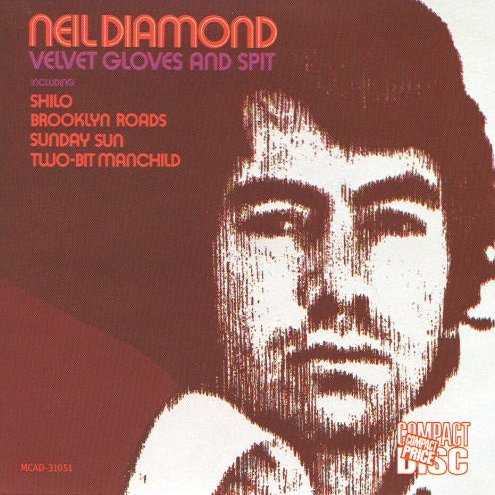 | Album: 10 of 48 Title: Velvet Gloves and Spit Released: 1970-10 Tracks: 11 Duration: 34:18 Scroll: Up Down Top Bottom 25% 50% 75% Spotify Allmusic Wikipedia AlbumCover | 1 Two-Bit Manchild (03:08) 2 A Modern Day Version of Love (02:51) 3 Honey-Drippin’ Times (02:03) 4 The Pot Smoker’s Song (04:04) 5 Brooklyn Roads (03:38) 6 Shilo (02:57) 7 Sunday Sun (02:48) 8 Holiday Inn Blues (03:18) 9 Practically Newborn (03:30) 10 Knackelflerg (02:25) 11 Merry-Go-Round (03:31) |
| Velvet Gloves and Spit : Allmusic album Review : Neil Diamonds debut LP for Uni Records and his earliest extant album, Velvet Gloves and Spit has appeared in two distinctly different versions. Originally issued in October of 1968 as a ten-song LP with a photograph of Diamond in close-up on the cover, it attracted relatively little attention despite some excellent songs and one bold (if heavy-handed and misguided) effort at serious, topical songwriting. That album never sold well -- none of Diamonds albums did in those days -- and two years later, in October of 1970, it was re-released with a new cover, featuring an artists rendition of Diamond, and an 11th song -- Diamonds version of "Shilo," which hed previously recorded for Bang Records -- added to it. Apart from "Shilo," most of the record was cut in New York (as opposed to the smoother, more subtly soulful, elegant sounding Memphis-based recordings that would follow) and a lot of Velvet Gloves and Spit sounds closer in texture to "Cherry Cherry" and the other sides cut by Diamond during his Brill Building phase at Bang Records through 1967, than to "Sweet Caroline" and the other records with which Diamond closed out the 60s. There are some fine songs here, including "Honey Dripping Time," "Practically Newborn," "Holiday Inn Blues," and "Sunday Sun," and "Two-Bit Manchild" is a fascinating adaptation of his Brill Building-era sound to a personal/introspective lyric and approach (imagine the Monkees sound melded to a singer/songwriter persona). To appreciate this album, however, one must get past "The Pot Smokers Song," a heavy-handed, anti-drug, bubblegum pop number, patterned roughly after Simon & Garfunkels "Old Friends/Bookends," with trippy spoken word testimonials about the dangers of drugs (including one addict who claims to shoot heroin into his spine), punctuated by Diamonds ridiculous sing-song chorus ("Pot, pot/Gimme some pot/Forget who you are/You can be who youre not"). Its a strangely fascinating artifact and helps distinguish Velvet Gloves and Spit from Diamonds catalog of uneven albums. Also present is "Shilo," recorded at Chips Momans American Studios in Memphis, which jumps ahead, presenting Diamond in his next stylistic phase with the sound that would carry him into the 70s. | ||
 | Album: 11 of 48 Title: Stones Released: 1971 Tracks: 10 Duration: 33:15 Scroll: Up Down Top Bottom 25% 50% 75% Spotify Allmusic Wikipedia AlbumCover | 1 I Am… I Said (03:34) 2 The Last Thing on My Mind (03:35) 3 Husbands and Wives (03:47) 4 Chelsea Morning (02:38) 5 Crunchy Granola Suite (02:56) 6 Stones (03:05) 7 If You Go Away (03:49) 8 Suzanne (04:41) 9 I Think Its Gonna Rain Today (02:35) 10 I Am… I Said (reprise) (02:31) |
| Stones : Allmusic album Review : Driven by the hit singles "I Am...I Said" and "Crunchy Granola Suite," Stones is a stronger album than most of Neil Diamonds late-60s records. Instead of padding the album with mediocre originals, Diamond picked several fine covers to fill out the remainder of the album, including Roger Millers "Husbands and Wives," Joni Mitchells "Chelsea Morning," Leonard Cohens "Suzanne," Randy Newmans "I Think Its Gonna Rain," Jacques Brels "If You Go Away," and Tom Paxtons "The Last Thing on My Mind." There are still a few weak patches on Stones, but the record remains an engaging collection of mainstream pop. | ||
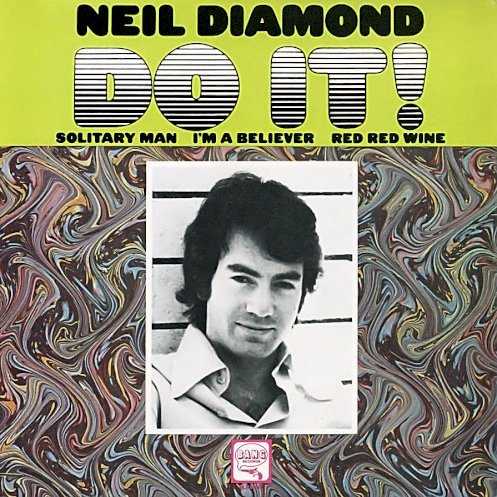 | Album: 12 of 48 Title: Do It! Released: 1971 Tracks: 12 Duration: 31:10 Scroll: Up Down Top Bottom 25% 50% 75% AlbumCover | 1 Do It (01:52) 2 Solitary Man (02:38) 3 Red, Red Wine (02:41) 4 Ill Come Running (03:04) 5 Love to Love (02:22) 6 Some Day Baby (02:20) 7 Shot Down (02:41) 8 Crooked Street (02:27) 9 The Boat That I Row (02:50) 10 Im a Believer (02:50) 11 Youll Forget (02:51) 12 The Long Way Home (02:33) |
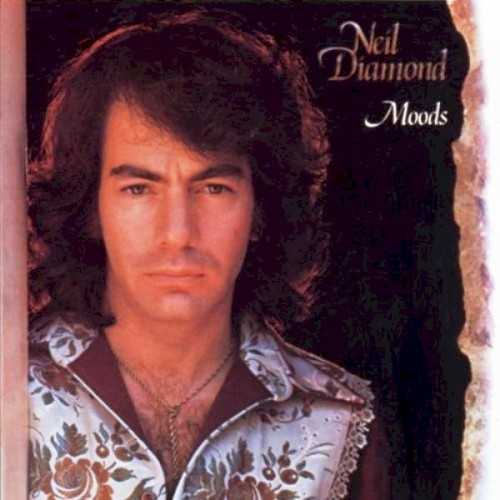 | Album: 13 of 48 Title: Moods Released: 1972 Tracks: 11 Duration: 33:34 Scroll: Up Down Top Bottom 25% 50% 75% Spotify Allmusic Wikipedia AlbumCover | 1 Song Sung Blue (03:15) 2 Porcupine Pie (02:05) 3 High Rolling Man (02:34) 4 Canta Libre (04:47) 5 Captain Sunshine (03:24) 6 Play Me (03:52) 7 Gitchy Goomy (03:53) 8 Walk on Water (03:06) 9 Theme (01:38) 10 Prelude in E major (00:33) 11 Morningside (04:24) |
| Moods : Allmusic album Review : Moods finds Neil Diamond attempting to craft a more ambitious and substantial album than his usual pop record through heavy orchestration, but the results only work when he sticks to catchy pop-rock, as on "Song Sung Blue," "High Rolling Man," and "Play Me." | ||
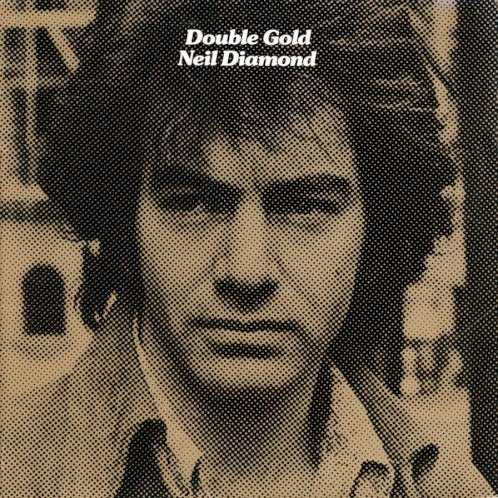 | Album: 14 of 48 Title: Double Gold Released: 1973 Tracks: 21 Duration: 56:55 Scroll: Up Down Top Bottom 25% 50% 75% Allmusic AlbumCover | 1 Im a Believer (02:47) 2 Monday Monday (03:05) 3 The Long Way Home (02:33) 4 Ill Come Running (03:04) 5 Red, Red Wine (02:41) 6 Solitary Man (02:34) 7 New Orleans (02:30) 8 Cherry Cherry (02:44) 9 Some Day Baby (02:20) 10 Girl Youll Be a Woman Soon (02:59) 11 Shilo (03:29) 12 Do It (02:23) 13 Oh No No (I Got the Feeling) (02:15) 14 Love To Love - Trio Music (02:23) 15 Thank the Lord for the Night Time (03:01) 16 Kentucky Woman (02:27) 17 The Boat That I Row (02:50) 18 You Got to Me (02:49) 19 Youll Forget (02:51) 20 Crooked Street (02:27) 21 Shot Down (02:41) |
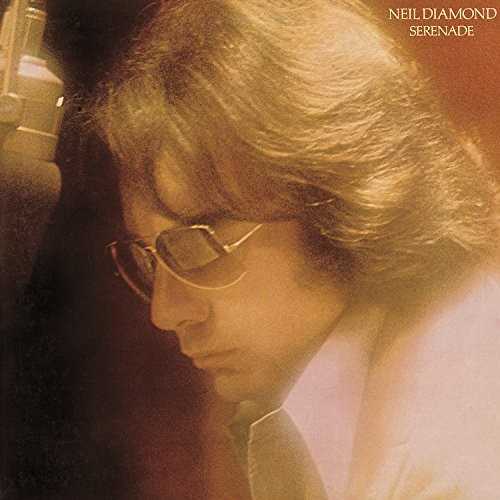 | Album: 15 of 48 Title: Serenade Released: 1974 Tracks: 8 Duration: 32:43 Scroll: Up Down Top Bottom 25% 50% 75% Spotify Allmusic Wikipedia AlbumCover | 1 Ive Been This Way Before (03:48) 2 Rosemarys Wine (02:42) 3 Lady Magdalene (07:01) 4 The Last Picasso (04:27) 5 Longfellow Serenade (03:52) 6 Yes I Will (04:39) 7 Reggae Strut (03:50) 8 The Gift of Song (02:22) |
| Serenade : Allmusic album Review : Neil Diamonds first regular album release for Columbia Records, following the success of the movie soundtrack Jonathan Livingston Seagull, Serenade is a slight effort characterized by Diamonds attempts to make pop sentiments seem more profound by grafting more auspicious art references onto them. But whether hes name-dropping Picasso or Longfellow, Diamond still has greeting card sentiments on his mind. Nevertheless, the catchiest of these autodidactic exercises, "Longfellow Serenade," which combines comments about "winged flight" with the exhortation, "Come on, baby, ride," was a Top Ten hit. | ||
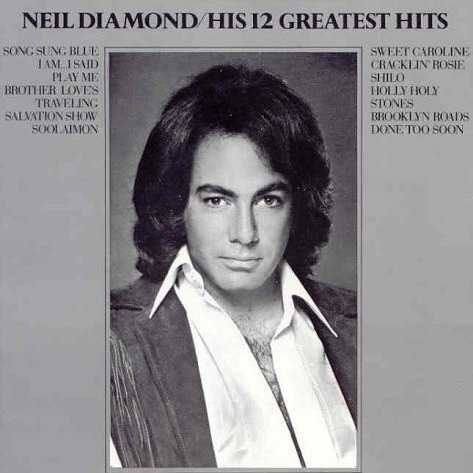 | Album: 16 of 48 Title: His 12 Greatest Hits Released: 1974 Tracks: 12 Duration: 42:04 Scroll: Up Down Top Bottom 25% 50% 75% Spotify Allmusic Wikipedia AlbumCover | 1 Sweet Caroline (03:32) 2 Brother Love’s Travelling Salvation Show (03:27) 3 Shilo (02:57) 4 Holly Holy (04:40) 5 Brooklyn Roads (03:40) 6 Cracklin’ Rosie (02:59) 7 Play Me (03:52) 8 Done Too Soon (02:41) 9 Stones (03:05) 10 Song Sung Blue (03:15) 11 Soolaimon (04:18) 12 I Am… I Said (03:34) |
| His 12 Greatest Hits : Allmusic album Review : Actually, His 12 Greatest Hits consists of 12 songs that were hits for Neil Diamond on Uni between 1969 and 1972. "Cracklin Rosie" is here, along with Diamonds other chart-topper of the period, "Song Sung Blue," and the Top Ten hits "Sweet Caroline" and "Holly Holy." | ||
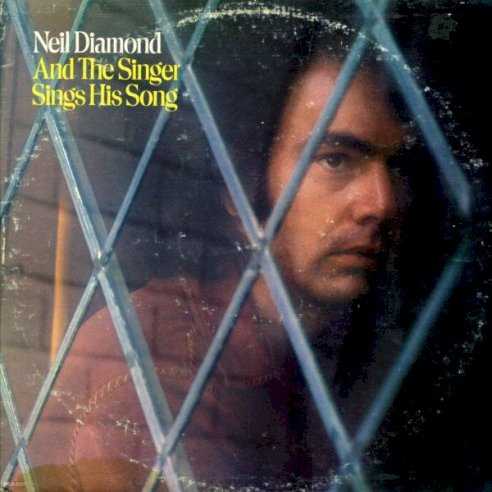 | Album: 17 of 48 Title: And the Singer Sings His Song Released: 1976 Tracks: 12 Duration: 38:56 Scroll: Up Down Top Bottom 25% 50% 75% Allmusic AlbumCover | 1 Captain Sunshine (03:20) 2 Free Life (03:11) 3 Hurtin’ You Don’t Come Easy (02:32) 4 Coldwater Morning (03:19) 5 Walk on Water (03:04) 6 Stones (03:04) 7 And the Grass Won’t Pay No Mind (03:32) 8 If I Never Knew Your Name (03:17) 9 Merry Go Round (03:29) 10 Juliet (02:52) 11 Brooklyn Roads (03:37) 12 And the Singer Sings His Song (03:39) |
| And the Singer Sings His Song : Allmusic album Review : A somewhat entertaining collection of Neil Diamonds lesser-known melodies brought forth here under the title And the Singer Sings His Song. Certainly a few positives come to light from this record. The songs are charming, romantic, and easy to dance to. Perfect for a getaway excursion from reality and off to your favorite beached island. With a record player and the voice of the 70s pop-dance era by ones side, the day would feel just suitable for relaxation, rest, and some recreation. Opening up with the stirring and catchy "Captain Sunshine" to the sweeping percussion and rhythms of "Free Life" and the la-las of "Stones," Neil Diamond plays the role of the entertainer to a capital "E." Off in the neighboring background is a pleasant array of orchestral arrangements that fit and mesh evenly with the tunes, weaving into the fabric like classical melodic patterns. The records back side finds highlights such as "If I Never Knew Your Name" and the ballad "Juliet," which provide spark to any romance sweet and light. Ending the record with a pulse and grand finale is the title song "And the Singer Sings His Song," sung by none other than Neil Diamond. Though not one of his better achievements, this record merits a must-have in the collection for the die-hard Diamond fan. | ||
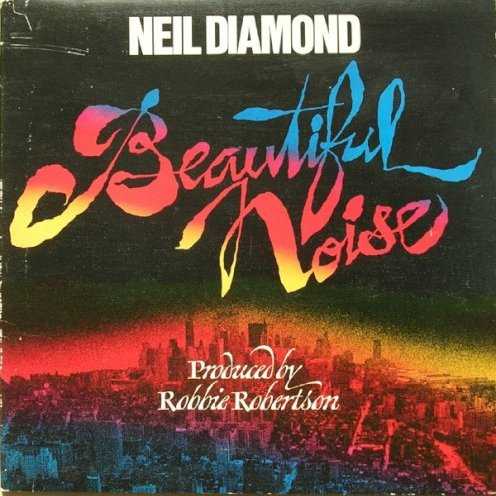 | Album: 18 of 48 Title: Beautiful Noise Released: 1976 Tracks: 11 Duration: 37:37 Scroll: Up Down Top Bottom 25% 50% 75% Spotify Allmusic Wikipedia AlbumCover | 1 Beautiful Noise (03:25) 2 Stargazer (02:43) 3 Lady-Oh (03:54) 4 Dont Think... Feel (03:27) 5 Surviving the Life (03:43) 6 If You Know What I Mean (03:42) 7 Street Life (03:02) 8 Home Is a Wounded Heart (02:44) 9 Jungletime (03:11) 10 Signs (04:20) 11 Dry Your Eyes (03:23) |
| Beautiful Noise : Allmusic album Review : Beautiful Noise, Neil Diamonds 11th studio album in the ten years since he emerged with his first chart single "Solitary Man," announces its ambitions on its cover, which displays the skyline of Manhattan under a red horizon and a black sky, overlaid with the words "Produced by Robbie Robertson." Most albums, of course, do not announce the name of the producer on the front cover, but Diamond wants to let people know that Beautiful Noise is an event. That he had convinced his Malibu, California, neighbor, the Bands guitarist and songwriter, to produce him was a surprise not only because he had worked with longtime producer Tom Catalano off and on dating back to his first solo singles session in 1963, but also because Robertson possesses the kind of rock credentials Diamond had never been granted. Further, as that ominous cover and Diamonds record sleeve epitaph ("...tin pan alley died hard, but there was always the music to keep you going") indicate, Beautiful Noise was intended as something of a concept album, the songwriters look back at his days as a scuffling denizen of the Brill Building in the early 60s. This theme comes out immediately in the rousing title song, in which he sings of the inspiration that the citys sounds bring to him. Thereafter, the story line seems to get lost, at least in lyrical terms, but Diamond and Robertson give each track its own musical identity: "Stargazer" employs a Dixieland arrangement, complete with wailing horns; "Lady-Oh" is the discs romantic ballad; "Dont Think … Feel" has a Caribbean rhythm; "Surviving the Life" is in gospel style; "Street Life" has a jazz/R&B; feel with a vocalese melody; "Home Is a Wounded Heart" is the torch song; and "Jungletime" is the rock & roll number. The heart of the album (and its leadoff single) is "If You Know What I Mean," in which Diamond looks back with regret and a sense of loss on his youth, "when we gave it away for the sake of a dream/In a penny arcade, if you know what I mean." What he seems to mean, among other things, is that his idealism was betrayed by greedy people, perhaps not a surprising sentiment for a man who, as this album was made, was still in litigation over his early recording and publishing contracts. With Robertsons help (and that of a lot of other musicians), Beautiful Noise is certainly the best-sounding and most consistently engaging album of Diamonds career up to 1976. | ||
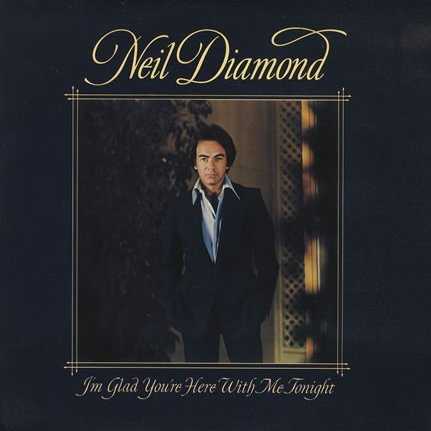 | Album: 19 of 48 Title: Im Glad Youre Here With Me Tonight Released: 1977 Tracks: 10 Duration: 38:18 Scroll: Up Down Top Bottom 25% 50% 75% Spotify Allmusic Wikipedia AlbumCover | 1 God Only Knows (04:00) 2 Let Me Take You in My Arms Again (02:57) 3 Once in a While (02:49) 4 Let the Little Boy Sing (03:29) 5 Im Glad Youre Here With Me Tonight (04:20) 6 Lament in D Minor / Dance of the Sabres (05:58) 7 Desirée (03:20) 8 As If (03:29) 9 You Dont Bring Me Flowers (03:11) 10 Free Man in Paris (04:42) |
| I'm Glad You're Here With Me Tonight : Allmusic album Review : Im Glad Youre Here With Me Tonight suffers from stilted, polished production, and a poor selection of songs; "Free Man in Paris" and "God Only Knows" may be great songs, but theyre not suited to Diamonds easy listening arrangements. Only "You Dont Bring Me Flowers" stands out among the bland filler, and that is better heard on his subsequent album, also titled You Dont Bring Me Flowers. | ||
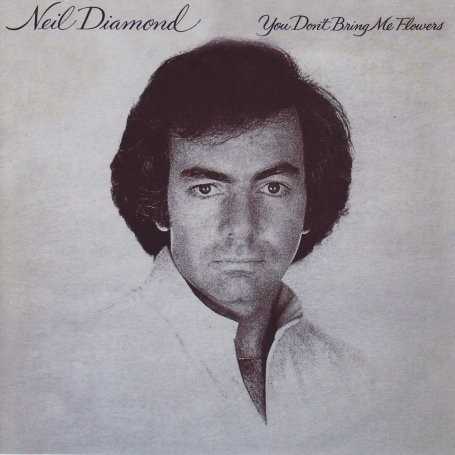 | Album: 20 of 48 Title: You Dont Bring Me Flowers Released: 1978 Tracks: 10 Duration: 41:10 Scroll: Up Down Top Bottom 25% 50% 75% Spotify Allmusic AlbumCover | 1 The American Popular Song (05:16) 2 Forever in Blue Jeans (03:39) 3 Remember Me (05:03) 4 You’ve Got Your Troubles (03:53) 5 You Don’t Bring Me Flowers (03:15) 6 The Dancing Bumble Bee / Bumble Boogie (04:54) 7 Mothers and Daughters / Fathers and Sons (04:11) 8 Memphis Flyer (03:11) 9 Say Maybe (04:07) 10 Diamond Girls (03:37) |
| You Don't Bring Me Flowers : Allmusic album Review : Neil Diamond -- the voice, the artist, the entertainer -- is best described through this record as a rhapsody of American pop culture during this period in the late 70s. Directly and appropriately, Diamond sings with sincerity that "the American popular song goes on." Perhaps this record best demonstrates a mission statement of creating an endearing work of music that all Americans can feel happy and satisfied with. Much of the material is uplifting, both in tempo and lyrical expression. Other songs are emotionally gripping and romantically involved. The work as a whole seems to be vintage Diamond, and does not stand out from any of his other records as unique. However, there is one duet that breaks the mold: his passionate showing with Barbra Streisand on the cover song, "You Dont Bring Me Flowers," a slow, powerful, and troubling ballad for those drifting out of relationships. "Forever in Blue Jeans" is the anthem that caught on with easy pop listeners in the late 70s, and continues to be a staple song for Diamond. "Remember Me" is a gentle song of longing and memories concerning past friendships, past loves, and places traveled. The typical Diamond sound is expressed here to perfection, with the vocals of Diamond backed by a stirring and articulate orchestra. The record doesnt dive into any deep ocean of creativity, nor does it strive to meet jazzier expectations. The arrangements and the songwriting are written just well enough to appeal to the easy listening audience, and the marching percussions of Diamonds songs fit the grade. Such a well-performed song of percussion and charging tempo is the cover, "Youve Got Your Troubles." Sung with passion and grace, this is Neil Diamond during his peak, and merits a listen for all late-70s enthusiasts. | ||
 | Album: 21 of 48 Title: September Morn Released: 1979 Tracks: 10 Duration: 37:58 Scroll: Up Down Top Bottom 25% 50% 75% Spotify Allmusic Wikipedia AlbumCover | 1 September Morn (03:53) 2 Mama Dont Know (03:57) 3 That Kind (03:19) 4 Jazz Time (03:30) 5 The Good Lord Loves You (04:45) 6 Dancing in the Street (04:12) 7 The Shelter of Your Arms (04:07) 8 Im a Believer (02:25) 9 The Sun Aint Gonna Shine Anymore (03:39) 10 Stagger Lee (04:09) |
| September Morn : Allmusic album Review : On September Morn, Neil Diamond began to push the borders of easy listening, concentrating more on immaculately polished studiocraft than songcraft. The songs are quite inconsistent, and even the best songs -- "Dancing in the Street," "The Sun Aint Gonna Shine Anymore," "Stagger Lee" -- are given inappropriately stiff and colorless arrangements. The title track nearly reaches the adult contemporary heights of "You Dont Bring Me Flowers," but overall the record demonstrates little personality. | ||
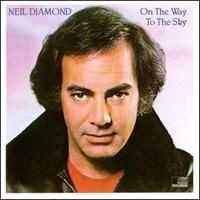 | Album: 22 of 48 Title: On the Way to the Sky Released: 1981 Tracks: 11 Duration: 42:21 Scroll: Up Down Top Bottom 25% 50% 75% Spotify Allmusic Wikipedia AlbumCover | 1 Yesterdays Songs (02:53) 2 On the Way to the Sky (03:47) 3 Right by You (03:37) 4 Only You (04:41) 5 Save Me (03:23) 6 Be Mine Tonight (02:43) 7 The Drifter (04:56) 8 Fear of the Marketplace (04:18) 9 Rainy Day Song (04:32) 10 Guitar Heaven (03:38) 11 Love Burns (03:47) |
| On the Way to the Sky : Allmusic album Review : Neil Diamond, in the opinion of many critics and fans, went into an artistic decline in the mid- to late- 70s. It turns out that he still had a number of good songs left in him, though, and the inconsistency of his later efforts should be viewed in context. That is to say, even Diamonds most respected albums had their share of oddball experiments and misguided moments, and the argument could be made that those peculiar detours make him a more interesting songwriter overall. On the Way to the Sky is typically uneven with a handful of strong songs that were big adult contemporary hits: "Yesterdays Songs," "On the Way to the Sky," and "Be Mine Tonight." The character of these songs is no different from his earlier adult pop efforts, but the production may be too slick for many listeners tastes. Throughout the album Diamond revisits some of his favorite themes -- rambling, traveling minstrelsy, the transcendent power of music -- which he sings about in his dramatic, gravelly style. Dedicated fans will find much to like, but those who take a more conditional approach to Diamonds music will be put off by the ultra-commercial sheen. The album even has its own "Knackelflerg" with the unusual "Fear of the Marketplace." | ||
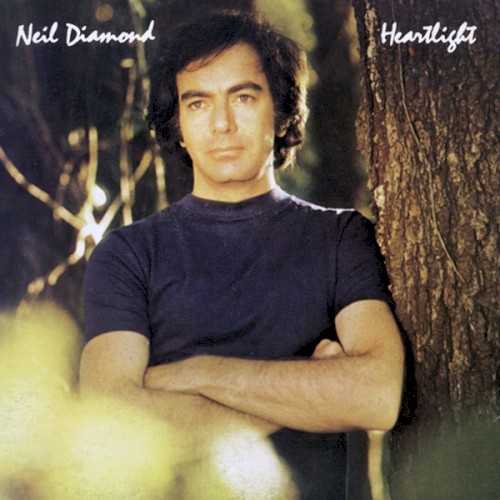 | Album: 23 of 48 Title: Heartlight Released: 1982 Tracks: 11 Duration: 40:30 Scroll: Up Down Top Bottom 25% 50% 75% Spotify Allmusic Wikipedia AlbumCover | 1 Heartlight (04:28) 2 Im Alive (03:48) 3 Im Guilty (03:17) 4 Hurricane (04:17) 5 Lost Among the Stars (03:57) 6 In Ensenada (03:49) 7 A Fool For You (03:01) 8 Star Flight (03:54) 9 Front Page Story (04:30) 10 Comin Home (02:37) 11 First You Have to Say You Love Me (02:47) |
| Heartlight : Allmusic album Review : Although Diamond has continued to sell healthy quantities of his albums and to fill arenas for his concerts, Heartlight and its title song, which was a Top Ten hit, were his last record releases as what might be called "a frontline artist," one who makes contemporary music for a contemporary audience and sells a million copies on release. Its a typical album for Diamond at this point, full of romantic sentiments rendered in highly produced settings and employing the cream of L.A. studio musicians, but lacking the excitement of his early work and the ambition of his middle period. | ||
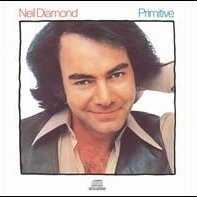 | Album: 24 of 48 Title: Primitive Released: 1984 Tracks: 11 Duration: 39:52 Scroll: Up Down Top Bottom 25% 50% 75% Spotify Allmusic AlbumCover | 1 Turn Around (03:45) 2 Primitive (04:26) 3 Fire on the Tracks (03:07) 4 Brooklyn on a Saturday Night (03:41) 5 Sleep With Me Tonight (03:42) 6 Crazy (03:41) 7 My Time With You (04:29) 8 Loves Own Song (03:32) 9 Its a Trip (Go for the Moon) (02:49) 10 You Make It Feel Like Christmas (03:58) 11 One by One (02:37) |
| Primitive : Allmusic album Review : Primitive attempts to capitalize on the easy listening success of Heartlight by replicating its sound and structure. In other words, its another collection of lightweight romantic ballads that are stifled by the immaculate production. Diamonds collaborations with Burt Bacharach ("Turn Around," "Sleep With Me Tonight," "Crazy") show some signs of life, particularly the graceful "Turn Around," but theyre not enough to save the album from being a generally uninvolving affair. | ||
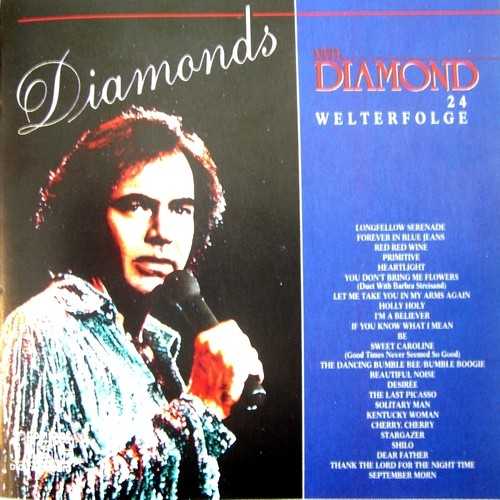 | Album: 25 of 48 Title: Diamonds: 24 Welterfolge Released: 1985 Tracks: 24 Duration: 1:28:55 Scroll: Up Down Top Bottom 25% 50% 75% AlbumCover | 1 Longfellow Serenade (03:51) 2 Forever in Blue Jeans (03:25) 3 Red, Red Wine (02:41) 4 Primitive (04:28) 5 Heartlight (04:25) 6 You Dont Bring Me Flowers (03:08) 7 Cherry, Cherry (02:42) 8 Stargazer (02:42) 9 Shilo (03:50) 10 Dear Father (05:15) 11 Thank the Lord for the Night Time (03:04) 12 September Morn (03:40) 1 Let Me Take You in My Arms Again (02:59) 2 Holly Holy (04:39) 3 Im a Believer (02:43) 4 If You Know What I Mean (03:40) 5 Be (06:32) 6 Sweet Caroline (04:03) 7 The Dancing Bumble Bee (04:56) 8 Beautiful Noise (03:24) 9 Desiree (03:20) 10 The Last Picasso (04:24) 11 Solitary Man (02:34) 12 Kentucky Woman (02:26) |
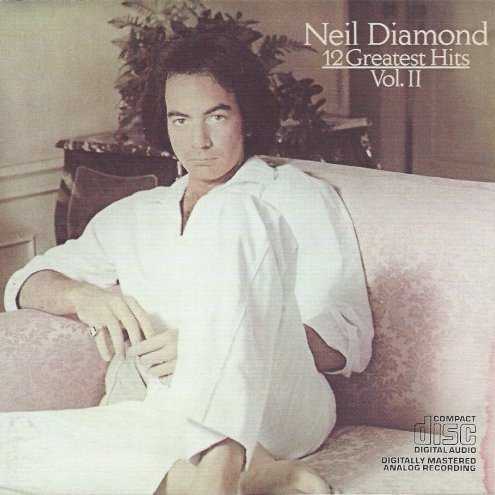 | Album: 26 of 48 Title: 12 Greatest Hits, Vol. II Released: 1985 Tracks: 12 Duration: 45:05 Scroll: Up Down Top Bottom 25% 50% 75% AlbumCover | 1 Beautiful Noise (03:25) 2 Hello Again (04:06) 3 Forever in Blue Jeans (03:24) 4 September Morn (03:53) 5 Desirée (03:20) 6 You Don’t Bring Me Flowers (03:26) 7 America (04:19) 8 Be (05:05) 9 Longfellow Serenade (03:52) 10 If You Know What I Mean (03:42) 11 Yesterday’s Songs (02:51) 12 Love on the Rocks (03:39) |
 | Album: 27 of 48 Title: His Very Best Released: 1985 Tracks: 20 Duration: 1:12:49 Scroll: Up Down Top Bottom 25% 50% 75% Allmusic AlbumCover | 1 You Dont Bring Me Flowers (03:17) 2 September Morn (03:53) 3 Beautiful Noise (03:25) 4 Hello Again (04:10) 5 If You Know What I Mean (03:45) 6 Kentucky Woman (02:26) 7 Heartlight (04:26) 8 Stargazer (02:45) 9 Holly Holy (04:43) 10 Solitary Man (02:33) 11 Forever in Blue Jeans (03:27) 12 Song Sung Blue (04:17) 13 Thank the Lord for the Night Time (03:05) 14 Cherry, Cherry (02:42) 15 Brother Loves Travelling Salvation Show (05:32) 16 Desirée (03:22) 17 Love on the Rocks (03:43) 18 Sweet Caroline (Good Times Never Seemed So Good) (04:05) 19 You Got to Me (02:47) 20 America (04:19) |
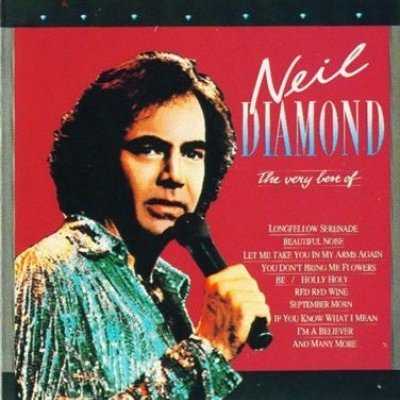 | Album: 28 of 48 Title: The Very Best of Neil Diamond Released: 1986 Tracks: 24 Duration: 1:29:13 Scroll: Up Down Top Bottom 25% 50% 75% Allmusic AlbumCover | 1 Longfellow Serenade (03:52) 2 Forever in Blue Jeans (03:25) 3 Red, Red Wine (02:41) 4 Primitive (04:24) 5 Heartlight (04:26) 6 You Dont Bring Me Flowers (03:10) 7 Let Me Take You in My Arms Again (03:00) 8 Holly Holy (04:39) 9 Im a Believer (02:43) 10 If You Know What I Mean (03:41) 11 Be (06:33) 12 Sweet Caroline (04:02) 1 The Dancing Bumble Bee/Bumble Boogie (04:57) 2 Beautiful Noise (03:23) 3 Desirée (03:20) 4 The Last Picasso (04:24) 5 Solitary Man (02:35) 6 Kentucky Woman (02:25) 7 Cherry Cherry (02:43) 8 Stargazer (02:43) 9 Shilo (03:51) 10 Dear Father (05:16) 11 Thank the Lord for the Night Time (03:04) 12 September Morn (03:43) |
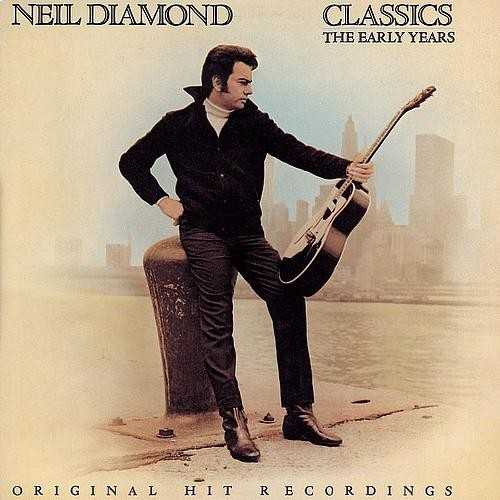 | Album: 29 of 48 Title: Classics: The Early Years Released: 1986 Tracks: 12 Duration: 33:30 Scroll: Up Down Top Bottom 25% 50% 75% Spotify Allmusic Wikipedia AlbumCover | 1 Kentucky Woman (02:26) 2 Cherry, Cherry (02:43) 3 Solitary Man (02:33) 4 You Got to Me (02:46) 5 I Got the Feelin (Oh No No) (02:13) 6 Thank the Lord for the Night Time (03:02) 7 Im a Believer (02:43) 8 Girl, Youll Be a Woman Soon (03:23) 9 Shilo (03:50) 10 Do It (02:22) 11 Red, Red Wine (02:41) 12 The Boat That I Row (02:42) |
| Classics: The Early Years : Allmusic album Review : Classics: The Early Years rounds up 12 highlights from Neil Diamonds recordings for Bang Records. These, of course, were Diamonds earliest recordings, and for many fans they remain among his very best work, and its easy to see why -- not only are these terrific songs, but the productions dont oversell the songs. Even when strings grace the productions, theres a dark, brooding vibe to the ballads, and a crisp feeling to the pop songs. And while some of the songs wont be instantly recognizable, most of them will, because these are the tunes that made Diamonds reputation as a songwriter and performer: "Kentucky Woman," "Cherry, Cherry," "Solitary Man," "Thank the Lord for the Night Time," "I"m a Believer," "Girl, Youll Be a Woman Soon," "Shilo," and "Red, Red Wine." Diamond occasionally matched these peaks later in his career, but never again did he deliver so many great songs at such a frequency -- and Classics conveniently collects them all in one place. | ||
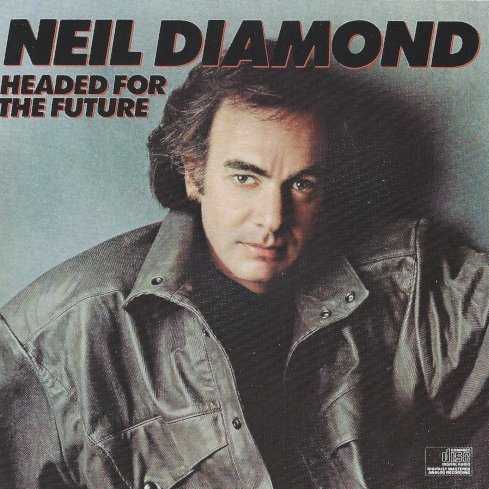 | Album: 30 of 48 Title: Headed for the Future Released: 1986 Tracks: 10 Duration: 39:48 Scroll: Up Down Top Bottom 25% 50% 75% Spotify Allmusic Wikipedia AlbumCover | 1 Headed for the Future (04:07) 2 The Man You Need (04:05) 3 I’ll See You on the Radio (Laura) (03:50) 4 Stand Up for Love (02:48) 5 It Should Have Been Me (04:30) 6 Lost in Hollywood (04:21) 7 The Story of My Life (03:44) 8 Angel (04:04) 9 Me Beside You (03:57) 10 Love Doesn’t Live Here Anymore (04:18) |
| Headed for the Future : Allmusic album Review : Having stumbled with Primitive, Diamond attempted, with Headed for the Future, to re-establish himself as a contemporary artist, co-writing with Stevie Wonder, recording songs by Bryan Adams and Maurice White of Earth, Wind & Fire, and employing nine producers and nine recording studios. The result was a slight upturn in sales and Diamonds last singles-chart entry with the title track. But the album was also overblown and unfocused, record-making by committee, and Neil Diamond as an individual artist was getting lost in the process. | ||
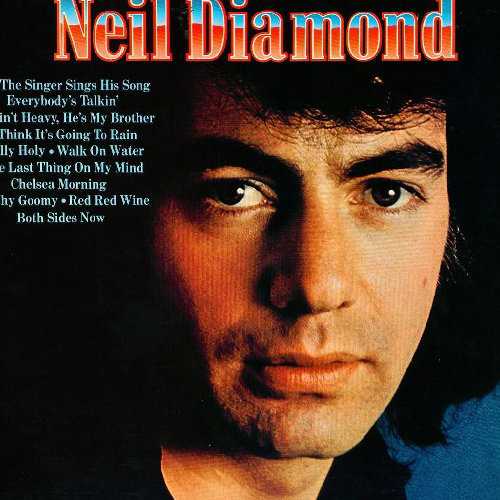 | Album: 31 of 48 Title: Solitary Man Released: 1987 Tracks: 16 Duration: 44:27 Scroll: Up Down Top Bottom 25% 50% 75% Allmusic AlbumCover | 1 Im a Believer (02:50) 2 The Boat That I Row (02:46) 3 Monday Monday (03:05) 4 Ill Come Running (03:04) 5 New Orleans (02:30) 6 Hanky Panky (02:50) 7 Girl Youll Be a Woman Soon (02:59) 8 Thank the Lord for the Nighttime (03:01) 9 Cherry Cherry (02:44) 10 You Got to Me (02:46) 11 La Bamba (02:13) 12 Solitary Man (02:34) 13 Oh No No (02:11) 14 Shilo (03:47) 15 Red, Red Wine (02:41) 16 Kentucky Woman (02:26) |
 | Album: 32 of 48 Title: The Very Best of Released: 1988 Tracks: 12 Duration: 43:42 Scroll: Up Down Top Bottom 25% 50% 75% AlbumCover | 1 Sweet Caroline (03:21) 2 Girl, You’ll Be a Woman Soon (02:48) 3 Walk on Water (03:02) 4 Soolaimon (04:23) 5 Morningside (04:56) 6 Cracklin’ Rosie (02:59) 7 Play Me (03:52) 8 Holly Holy (04:42) 9 Stones (03:06) 10 Song Sung Blue (03:15) 11 Brooklyn Roads (03:40) 12 I Am… I Said (03:34) |
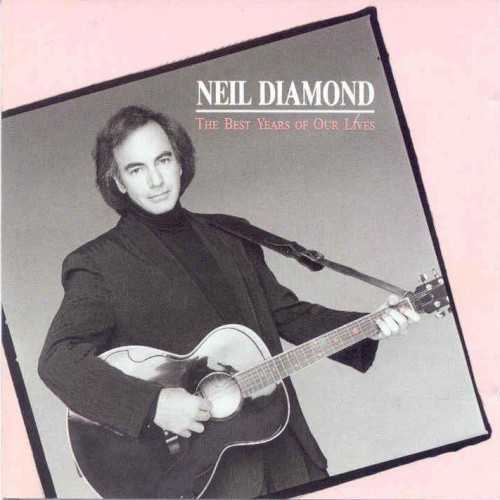 | Album: 33 of 48 Title: The Best Years of Our Lives Released: 1988 Tracks: 11 Duration: 45:14 Scroll: Up Down Top Bottom 25% 50% 75% Spotify Allmusic AlbumCover | 1 The Best Years of Our Lives (04:00) 2 Hard Times for Lovers (04:25) 3 This Time (03:57) 4 Everythings Gonna Be Fine (03:59) 5 Hooked on the Memory of You (03:53) 6 Take Care of Me (03:39) 7 Baby Can I Hold You (03:55) 8 Carmelitas Eyes (04:05) 9 Courtin Disaster (04:32) 10 If I Couldnt See You Again (04:02) 11 Long Hard Climb (04:42) |
| The Best Years of Our Lives : Allmusic album Review : This album came when Neil Diamond was firmly entrenched in his adult contemporary niche. A/C can be so pandering its insulting sometimes, but when its done with heart and smarts it can be sublime. Diamond apparently gets that and for the most part makes adult contemporary that is actually for adults. It takes a master to croon "Cause I do believe in forever/its a place that lovers find" without making the sentiment cringe-inducing. And Diamond pulls it off. Despite that, even he cant keep from sounding creepy when he sings, "Ooh, babe, youre a hot little number" on "Everythings Gonna be Fine." Both he and this album are classier than that, and once youre into the song its undeniable -- it becomes a feel-good anthem, and it works. Diamond was wise enough to co-write a number of these songs with master producer/songwriter David Foster. Foster writes his share of pabulum, but when hes good hes great, and on this album hes in fine form. Diamond was also wise enough to tone down the production so that his rugged voice and the melancholy melodies are able to shine through. The Best Years of Our Lives is an album that is romantic and sentimental without being manipulative, and despite a couple of overproduced ballads that are outweighed by the other tracks, particularly the high-spirited and hopeful title cut and the subtle remorse of "This Time," it is a strong entry in Diamonds oeuvre. | ||
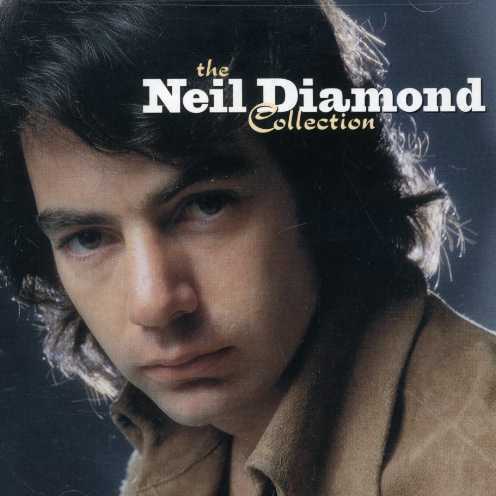 | Album: 34 of 48 Title: The Neil Diamond Collection Released: 1988 Tracks: 30 Duration: 1:44:33 Scroll: Up Down Top Bottom 25% 50% 75% Spotify Allmusic AlbumCover | 1 Sweet Caroline (Good Times Never Seemed So Good) (03:31) 2 Done Too Soon (02:40) 3 He Aint Heavy ... Hes My Brother (04:09) 4 Girl, Youll Be a Woman Soon (02:48) 5 Both Sides Now (03:31) 6 Holly Holy (04:41) 7 Soolaimon (04:17) 8 Song Sung Blue (03:13) 9 Everybodys Talkin (02:47) 10 And The Singer Sings His Song (03:38) 11 Thank The Lord For The Night Time (02:59) 12 Red, Red Wine (03:40) 13 Until Its Time For You To Go (03:31) 14 Play Me (03:49) 15 Kentucky Woman (02:34) 1 Brother Loves Travelling Salvation Show (03:26) 2 Stones (03:04) 3 Hurtin You Dont Come Easy (02:32) 4 Suzanne (04:40) 5 Shiloh (02:56) 6 I Am ... I Said (03:32) 7 Cherry, Cherry (03:08) 8 Walk On Water (03:06) 9 Mr. Bojangles (04:52) 10 Solitary Man (03:30) 11 Cracklin Rosie (02:57) 12 And The Grass Wont Pay No Mind (03:34) 13 Lordy (04:45) 14 Crunchy Granola Suite (02:54) 15 Brooklyn Roads (03:37) |
| The Neil Diamond Collection : Allmusic album Review : Although not as comprehensive an anthology of Neil Diamonds eight-album, four-year affiliation with MCA as 1992s 38-track double Glory Road, The Neil Diamond Collection is a definitive single-disc recap of one of his extensive careers most influential periods. Its a beautifully remastered, non-chronologically arranged 67 minutes of studio highlights from Diamonds most ambitious, if not his most commercially successful years. Only his version of "He Aint Heavy, Hes My Brother," the discs lone cover, is a questionable choice, but since it charted at number 20 in 1970, its inclusion is justified. Otherwise, this non-stop, hit-filled collection shifts from one radio standard to another, easily replacing the existing and rather anemic 12 Greatest Hits with its sound quality, depth and breadth. Dramatic, classic mini pop-operas like "Brother Loves Traveling Salvation Show," "Cracklin Rosie," and "Holly Holy" are as much a part of the late-60s singer/songwriter rubric as work from the eras more feted artists. The thoughtfully compiled 16-page booklet includes detailed track documentation, an extensive essay, and some rare pictures of the young artist, making this the essential single-disc representation of Neil Diamonds short, yet significant, MCA tenure. | ||
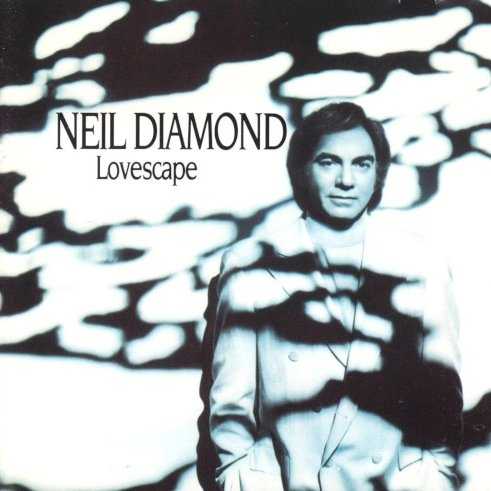 | Album: 35 of 48 Title: Lovescape Released: 1991 Tracks: 15 Duration: 1:00:42 Scroll: Up Down Top Bottom 25% 50% 75% Spotify Allmusic Wikipedia AlbumCover | 1 If There Were No Dreams (03:15) 2 Mountains of Love (04:53) 3 Dont Turn Around (03:49) 4 Someone Who Believes in You (04:14) 5 When You Miss Your Love (04:40) 6 Fortune of the Night (04:08) 7 One Hand, One Heart (03:02) 8 Hooked on the Memory of You (02:51) 9 Wish Everything Was Alright (03:52) 10 The Way (04:51) 11 Sweet L.A. Days (04:12) 12 All I Really Need Is You (04:21) 13 Lonely Lady #17 (03:58) 14 I Feel You (03:38) 15 Common Ground (04:50) |
| Lovescape : Allmusic album Review : Lovescape frames Neil Diamonds typically strong, if a little over-dramatic, vocal style with plinking keyboards, cooing backup singers, and hissing, breathy synthesizers. Its all drenched in the kind of reverb that screams "lite rock radio sap." Fortunately, Diamonds wine-stained voice is still full of emotion and more than capable of closing the albums gaping holes with a just-right emphasis here and a plaintive growl there. "Mountains of Love"s sanitized world beat groove and keening horns would shrivel in anyone elses hands. But when Neil sings "Come on lets go/Weve got room on that mountain of love," you want to believe in his feed-the-world message and follow him right to the top of the peak (how does he climb in those ankle boots?). A strummed acoustic guitar slows down the Hammond/Warren composition "Dont Turn Around," letting it breathe like the classic "Red Red Wine" -- Diamonds take has none of the mechanization of Ace of Bases later hit version. He has written or co-written 11 of Lovescapes 15 tracks, and its his lilting, bruised heart duet with Kim Carnes thats the obvious standout. Elsewhere, he covers "One Hand, One Heart" from West Side Story, refueling the ballad with his typical message of unification and peace, and buoys the faint country feel of "When You Miss Your Love" with a deft vocal touch, never letting it drift into dangerous Elton John territory. Although heaping helpings of synthesizer do their worst to slow him down, Diamond does his best with Lovescapes material, and salvages a handful of memorable moments for longtime listeners or the casual fan. | ||
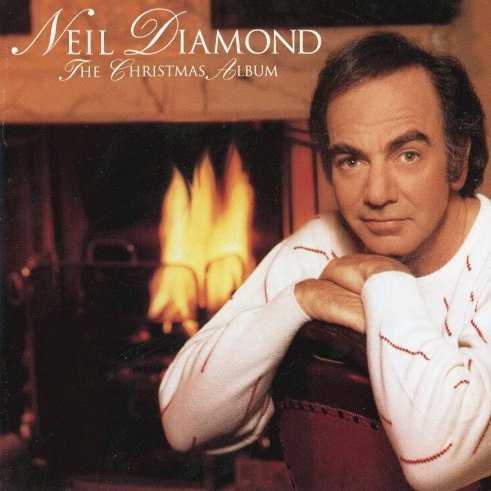 | Album: 36 of 48 Title: The Christmas Album Released: 1992 Tracks: 14 Duration: 45:32 Scroll: Up Down Top Bottom 25% 50% 75% Spotify Allmusic AlbumCover | 1 O Come, O Come Emmanuel / We Three Kings of Orient Are (02:57) 2 Silent Night (04:03) 3 Little Drummer Boy (03:57) 4 Santa Claus Is Coming to Town (03:25) 5 The Christmas Song (03:33) 6 Morning Has Broken (03:04) 7 Happy Christmas (War Is Over) (04:19) 8 White Christmas (03:55) 9 God Rest Ye Merry Gentlemen (01:20) 10 Jingle Bell Rock (01:51) 11 Hark the Herald Angels Sing (02:50) 12 Silver Bells (03:06) 13 You Make It Feel Like Christmas (03:38) 14 O Holy Night (03:28) |
| The Christmas Album : Allmusic album Review : While Neil Diamonds The Christmas Album is designed almost exclusively for his adult contemporary constituency, the vocalist still manages to light up most of the obviousness of these standards with his trademark gritty soul and flair for inflection. Opening with the grandeur of "O Come, O Come Emmanuel/We Three Kings of Orient Are" and "Silent Night," the album is awash in rich reds and golds almost immediately. But Diamond has fun with "Santa Claus Is Comin to Town," loosening up with a harmonica solo and a busy, up-tempo arrangement, and "Jingle Bell Rock" does just that with a 1950s doo wop vibe. These moves count as big risks on an album that otherwise tries on every possible Christmas album cliché: childrens choirs and histrionic adult ones, crashing cymbals, and tasteful piano thats as warm as a fireplace in December. Thankfully, even when the choirs threaten to outdo him, Diamond keeps the focus on his famous singing voice. A stirring a capella version of "God Rest Ye Merry Gentlemen" is a good example of this, and one of The Christmas Albums standouts. | ||
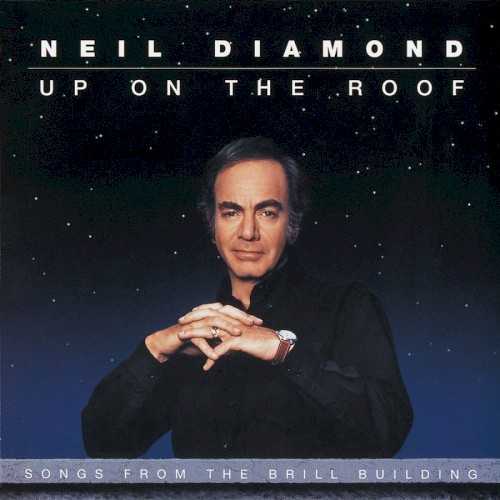 | Album: 37 of 48 Title: Up on the Roof: Songs From the Brill Building Released: 1993-09-28 Tracks: 16 Duration: 55:57 Scroll: Up Down Top Bottom 25% 50% 75% Spotify Allmusic Wikipedia AlbumCover | 1 Youve Lost That Loving Feelin (04:31) 2 Up on the Roof (03:31) 3 Love Potion Number 9 (03:05) 4 Will You Love Me Tomorrow (03:29) 5 Dont Be Cruel (03:46) 6 Do Wah Diddy Diddy (02:55) 7 I (Who Have Nothing) (04:05) 8 Do You Know the Way to San Jose? (03:03) 9 Dont Make Me Over (03:37) 10 River Deep - Mountain High (03:58) 11 A Groovy Kind of Love (02:52) 12 Spanish Harlem (03:43) 13 Sweets for My Sweet (02:53) 14 Happy Birthday Sweet Sixteen (03:39) 15 Ten Lonely Guys (04:16) 16 Save the Last Dance for Me (02:27) |
| Up on the Roof: Songs From the Brill Building : Allmusic album Review : This is Diamonds equivalent of, say, one of Barbra Streisands Broadway albums. Come to think of it, its Broadway that Diamond is returning to as well; specifically, the corner of 49th Street, where he and many others turned out songs for music publishers. Some of these songs were written there; most were only in the spirit of that modern Tin Pan Alley. Handling the work of his then-rivals, such as "Spanish Harlem," "A Groovy Kind of Love," and "River Deep -- Mountain High," Diamond adopts his usual hammy style (he always sounds like he thinks hes a much better singer than he is). Peter Asher patented a neo-60s production style in crafting oldies for Linda Ronstadt in the 70s, and he does the same thing here, which is only to say that the album is not as overproduced as some of Diamonds recent albums, not that Ashers versions are any competition to Phil Spectors originals. Actually, this record sounds exactly like you would expect it to: just call to mind a familiar song like "Will You Love Me Tomorrow" and imagine what it would sound like if Neil Diamond sang it. While this is clearly a holding action from the point of view of Diamonds recording career, fans can decide for themselves whether its valid and, perhaps more problematic, necessary. You pays your money... | ||
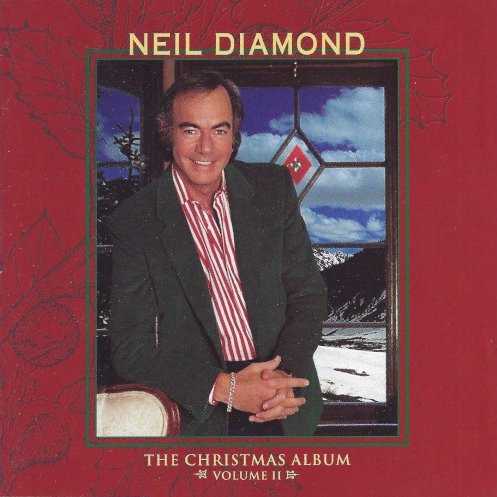 | Album: 38 of 48 Title: The Christmas Album Volume II Released: 1994 Tracks: 15 Duration: 50:18 Scroll: Up Down Top Bottom 25% 50% 75% Spotify AlbumCover | 1 Joy to the World (02:40) 2 Marys Little Boy Child (02:59) 3 Deck the Halls / We Wish You a Merry Christmas (01:42) 4 Winter Wonderland (02:44) 5 Have Yourself a Merry Little Christmas (04:44) 6 Ill Be Home for Christmas (03:42) 7 Rudolph the Red-Nosed Reindeer (04:04) 8 Sleigh Ride (02:43) 9 Candlelight Carol (04:09) 10 Away in a Manger (02:33) 11 O Come All Ye Faithful (04:15) 12 O Little Town of Bethlehem (03:35) 13 Angels We Have Heard on High (03:17) 14 The First Noel (03:34) 15 Hallelujah Chorus (03:31) |
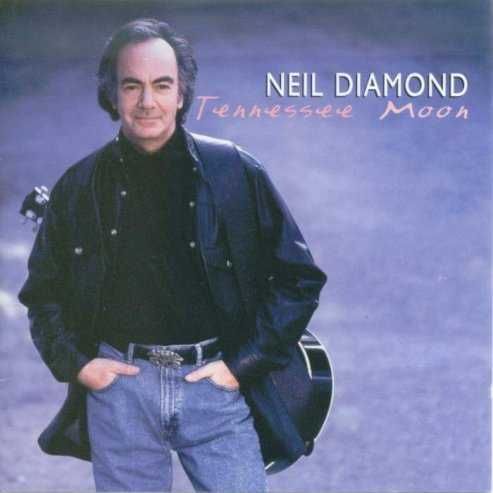 | Album: 39 of 48 Title: Tennessee Moon Released: 1996 Tracks: 18 Duration: 1:08:04 Scroll: Up Down Top Bottom 25% 50% 75% Spotify Allmusic Wikipedia AlbumCover | 1 Tennessee Moon (03:00) 2 One Good Love (04:18) 3 Shame (03:30) 4 A Matter of Love (04:35) 5 Marry Me (03:51) 6 Deep Inside of You (03:53) 7 Gold Dont Rust (03:43) 8 Like You Do (04:05) 9 Can Anybody Hear Me (03:51) 10 Win the World (04:12) 11 No Limit (03:08) 12 Reminisce for a While (04:28) 13 Kentucky Woman (02:49) 14 If I Lost My Way (03:23) 15 Everybody (03:47) 16 Talking Optimist Blues (Good Day Today) (02:54) 17 Open Wide These Prison Doors (04:31) 18 Blue Highway (03:56) |
| Tennessee Moon : Allmusic album Review : Neil Diamond mounted a major comeback with Tennessee Moon, his first collection of new material in nearly five years. Instead of capitalizing on the psuedo-hipster status he had acquired with the early 90s alternative rockers, particularly Urge Overkill, Diamond headed to Nashville to write and record Tennessee Moon. Appropriately, the album is rooted in contemporary country, spiked with hints of the pop craftsmanship that made him popular in the 60s. Not all of the songs were written by Diamond or his collaborators, which included Raul Malo of the Mavericks; the combination of originals and professionally-written made-to-order songs works well, leaving the overall quality of the material rather high. Tennessee Moon suffers from an overabundance of songs, as well as a slightly sterile production, but it remains one of Neil Diamonds most successful records of the 80s and 90s. | ||
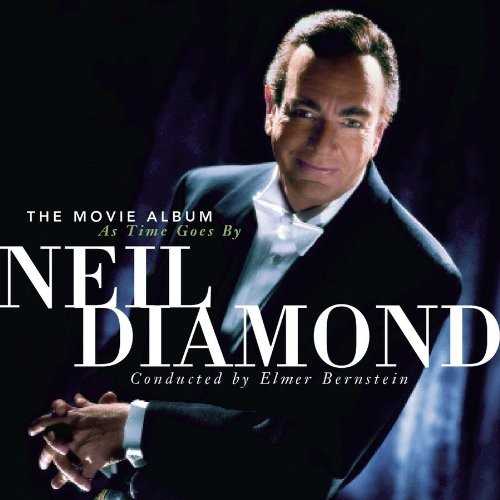 | Album: 40 of 48 Title: The Movie Album: As Time Goes By Released: 1998-10-27 Tracks: 10 Duration: 33:34 Scroll: Up Down Top Bottom 25% 50% 75% Spotify Allmusic Wikipedia AlbumCover | 1 True Love (03:12) 2 My Heart Will Go On (04:13) 3 The Look of Love (04:00) 4 In the Still of the Night (04:40) 5 Moon River (03:32) 6 Ruby (03:16) 7 Suite Sinatra: Ive Got You Under My Skin/One for My Baby (04:22) 8 And I Love Her (02:25) 9 Cant Help Falling in Love (03:07) 10 As Time Goes By (reprise) (00:44) |
| The Movie Album: As Time Goes By : Allmusic album Review : On this lazy, nearly shameless album (two CDs that dont even make it to 70 minutes combined), Neil Diamond visits movie songs past ("As Time Goes By") and present ("My Heart Will Go On") with stops along the way for takes on almost anything you would anticipate an album and artist like this would cover ("Unchained Melody"? There. "Can You Feel the Love Tonight"? Ditto. "Moon River"? Yep, its there.) Assisted by conductor Elmer Bernstein and an 80-piece orchestra, Diamond takes a 20-song stroll down film memory lane on The Movie Album: As Time Goes By with a bombast that often borders on parody. Oversinging like hes never oversung before, Diamond makes even the most inspired tunes of the bunch ("And I Love Her," "Cant Help Falling in Love") into Branson-worthy set pieces that are all melodramatic glitz and no style. A black stain on both Diamond and movies. | ||
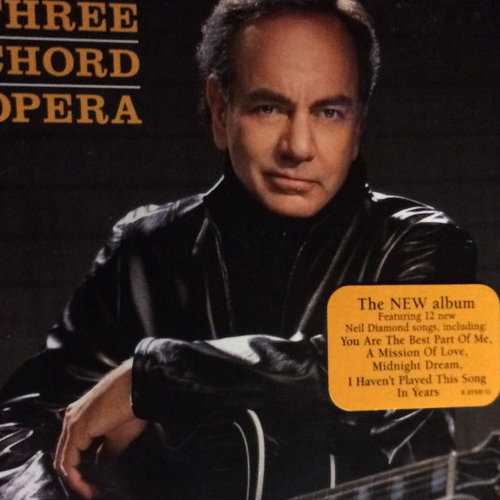 | Album: 41 of 48 Title: Three Chord Opera Released: 2001 Tracks: 12 Duration: 47:19 Scroll: Up Down Top Bottom 25% 50% 75% Spotify Allmusic Wikipedia AlbumCover | 1 I Havent Played This Song in Years (04:23) 2 Dont Look Down (03:08) 3 I Believe in Happy Endings (04:28) 4 At the Movies (03:39) 5 Midnight Dream (04:57) 6 You Are the Best Part of Me (04:02) 7 Baby Lets Drive (04:35) 8 My Special Someone (03:35) 9 A Mission of Love (04:15) 10 Elijahs Song (02:56) 11 Leave a Little Room for God (02:53) 12 Turn Down the Lights (04:23) |
| Three Chord Opera : Allmusic album Review : Columbia records billed Neil Diamonds Three Chord Opera as his first album of all-original material in 27 years (since 1974s Serenade), which was true, but deceptive. Diamond wrote most of his songs for most of his career, but often included cover songs on his albums. It would be more accurate to describe Three Chord Opera as Diamonds first straightforward album in a decade, since he followed 1991s Lovescape with a series of all-covers albums, hits compilations, Christmas albums, and live recordings; his last album containing mostly (co-written) originals was 1996s country-oriented Tennessee Moon. However you date Diamonds songwriting lay-off, though, the expectation is that the result will be a more personal statement than his recent albums, and it is, at least in part. Diamond begins with "I Havent Played This Song in Years," a melancholy breakup song, and he returns to the theme of romantic loss on "Midnight Dream" and "A Mission of Love," while even the songs of apparently contented love ("I Believe in Happy Endings," "You Are the Best Part of Me," "My Special Someone") are dark around the edges. But Diamond is too conscious of pop conventions to devote a whole record to one mood, and, unable to break through a tendency toward cliché, he isnt really capable of writing a sustained self-examination anyway. So, he varies the tone with novelty songs like "At the Movies" and "Baby Lets Drive," and turns to unabashed sentiment on the lullaby "Elijahs Song" and the religious "Leave a Little Room for God." When Diamond joined with songwriting collaborators in the early 80s, his compositions became more homogenous, but less embarrassing, while his 90s work fostered the impression of him as a non-writing performer. Three Chord Opera is the old Neil Diamond, a wildly uneven writer with a certain ingratiating style. | ||
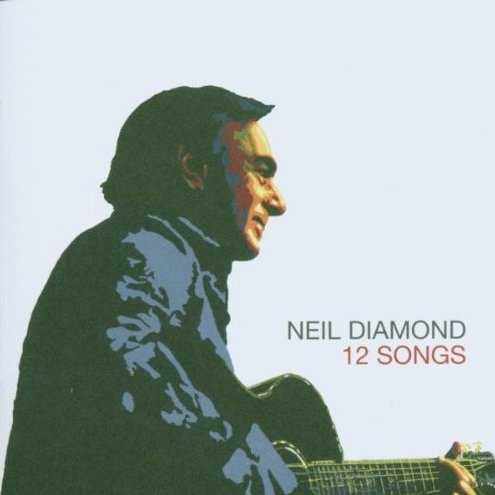 | Album: 42 of 48 Title: 12 Songs Released: 2005-11-08 Tracks: 14 Duration: 57:24 Scroll: Up Down Top Bottom 25% 50% 75% Spotify Allmusic Wikipedia AlbumCover | 1 Oh Mary (05:12) 2 Hell Yeah (04:25) 3 Captain of a Shipwreck (03:55) 4 Evermore (05:18) 5 Save Me a Saturday Night (03:31) 6 Delirious Love (03:12) 7 Im on to You (04:27) 8 Whats It Gonna Be (04:04) 9 Man of God (04:21) 10 Create Me (04:10) 11 Face Me (03:27) 12 We (03:49) 13 Men Are So Easy (04:04) 14 Delirious Love (03:23) |
| 12 Songs : Allmusic album Review : Calling 12 Songs Neil Diamonds best album in three decades may be a little misleading: truth be told, it doesnt have much competition in his discography. While Diamond never stopped making albums, he did seem progressively less interested in recording sometime after the Robbie Robertson-produced 1976 album Beautiful Noise. Following that weird, ambitious album, he pursued a slicker, streamlined course and started writing less original material. For a while, this paid off great commercial dividends, culminating in his 1980 remake of the Al Jolson film The Jazz Singer, but after 1982s Heartlight he slowly drifted off the pop charts. Over the next two decades, he toured regularly, turning out a new album every three or four years, and their patchwork nature of a few covers and a few originals suggested that Diamond wasnt as engaged in either the writing or recording process as he was at the peak of his career. With 2001s Three Chord Opera he delivered his first album of all-original material since Beautiful Noise, which was also his first non-concept album since 1991s Lovescape (he spent the interim cutting theme albums, such as a record devoted to Brill Building pop or a country-oriented collection). While it was uneven, it did suggest that Diamond was re-engaging with both writing and recording, and as he prepared material for a new record, he received word that producer Rick Rubin -- the man responsible for Johnny Cashs acclaimed 90s comeback, American Recordings -- was interested in working with him, and the two combined for the project that turned out to be 12 Songs. Rubin was the first producer to push Diamond since Robbie Robertson, but where Robertson indulged the singer/songwriter, Rubin drove Neil to strip his music down to his essence. As Diamonds candid liner notes reveal, Rubin wasnt a co-writer, he was a precise and exacting editor, encouraging Neil to rework songs, abandon some tunes, and to keep writing. The process worked, as Diamond wound up with a set of 12 songs (actually, 13 on the special edition that contains two bonus tracks, including an alternate version of "Delirious Love" featuring a delirious Brian Wilson contribution) that result in his most consistent set of songs ever. This is entirely Rubins doing, since hes the first producer to exercise such tight control over one of Diamonds albums. Where Tom Catalano, the producer of Neils 60s and early-70s work, let Diamond indulge in flights of fancy and sheer weirdness, Rubin keeps him on a tight leash, only allowing a couple of light, cheerful songs into the finished product. Instead of encouraging Neil to write these rollicking, effortlessly hooky pop songs, Rubin brings the moody undercurrents of "Girl, Youll Be a Woman Soon" and "Solitary Man" to the forefront, pushing Diamond toward somber, introspective territory that his music suggested but never truly explored in the past. To highlight this mood, Rubin keeps the arrangements spare, even skeletal, reminiscent of the monochromatic nature of his Cash collaborations. 12 Songs also shares with American Recordings a creeping sense of mortality, but where that sounded natural coming from Johnny Cash, its slightly affected here, since even when Diamond attempts to reach inward its offset by his natural inclination toward hamminess. And that flair for the theatrical almost begs out for arrangements that are a little bit more fleshed out than whats here -- not something as slickly cold as what he did in the late 70s, but something similar to the rich yet fruity orchestrations Catalano brought to Diamonds best songs. But if 12 Songs does occasionally come across as slightly affected in its intent and presentation, it also is inarguably Neil Diamonds best set of songs in a long, long time. Diamonds writing is not only more ambitious than it has been in years, but its also more fully realized; the songs are tightly written, with the melodies bringing out the emotions in the lyrics. Similarly, Diamond also sounds engaged as a performer, singing with passion and unexpected understatement; its his most controlled, varied vocal performance ever, and even if Rubins production is a bit too stark, it does force listeners to concentrate on the songs, which makes this a better case for Diamonds talents as a songwriter than most of his other albums. And thats why 12 Songs is, in a way, even more welcome than American Recordings. Where Cashs comeback confirmed what everybody already knew about him, this presents a side of Neil Diamond thats never been heard on record and, in the process, it offers a new way of looking at the rest of his catalog -- which is a pretty remarkable achievement, but the best thing about 12 Songs is that its simply one of the most entertaining, satisfying albums Diamond has ever released. | ||
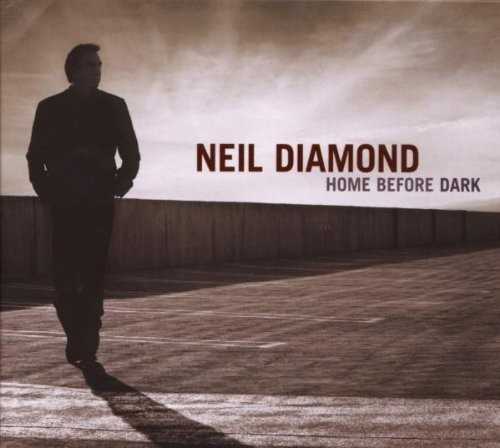 | Album: 43 of 48 Title: Home Before Dark Released: 2008-05-12 Tracks: 14 Duration: 1:12:28 Scroll: Up Down Top Bottom 25% 50% 75% Spotify Allmusic Wikipedia AlbumCover | 1 If I Dont See You Again (07:12) 2 Pretty Amazing Grace (04:53) 3 Dont Go There (06:03) 4 Another Day (That Time Forgot) (06:12) 5 One More Bite of the Apple (06:39) 6 Forgotten (04:22) 7 Act Like a Man (04:04) 8 Whose Hands Are These (03:11) 9 No Words (04:48) 10 The Power of Two (04:35) 11 Slow It Down (04:55) 12 Home Before Dark (06:28) 13 Without Her (04:22) 14 Make You Feel My Love (04:36) |
| Home Before Dark : Allmusic album Review : Home Before Dark is Neil Diamonds second collaboration with producer Rick Rubin. It follows the fine but ill-fated 12 Songs, which was sabotaged by Sonys "Rootkit" program scandal: a nefarious bit of "copy protection" software that invaded the operating system of PCs and wreaked havoc. 12 Songs had to be recalled from store shelves just as Diamond received better reviews than he had in a decade. Sony reissued it in 2007, but the damage was done. Diamond, disappointed but undaunted, sought out Rubin. Rubin enlisted Heartbreakers keyboardist Benmont Tench and lead guitarist Mike Campbell, studio guitarist/bassist Smokey Hormel, and former Chavez guitar slinger Matt Sweeney. There are no drums. David Campbell did some skeletal string arrangements, but thats it. In addition, Natalie Maines of the Dixie Chicks duets on the track "Another Day (That Time Forgot)." Home Before Dark is a more exposed Diamond than listeners have ever heard. Hes out there, bashing on his guitar and singing from a position of extreme vulnerability; hes on a wire without a net. His musicians understand what is so dynamically and poetically evident in the songs, and use painterly care in adorning them. Diamond is not a young man anymore and, thankfully, he doesnt write like one -- though he sounds lean and hungry for something just out of reach. "Forgotten" has a rock & roll progression worthy of his Bang singles. Its lyric reflects the travails of a protagonist whose heart bears hurt without the grace and wisdom that age is supposed to bring. The grain in his voice is fierce; it quavers just a bit in the refrain, and Sweeneys electric guitar nails it to the wall. It follows "One More Bite of the Apple," another rollicking rocker, but this one is about reuniting with his true beloved -- songwriting itself. Home Before Dark contains some beautiful love songs, too. "If I Dont See You Again," the albums opener, reflects the bittersweet aftertaste of lost love. Its classic Diamond. His character converses with a reflection, a ghost. The gorgeously crafted instrumental bridge and the sense of loneliness in the protagonists voice combine seamlessly. The albums first single is "Pretty Amazing Grace." Diamond sings a prayer of gratitude for rescue and restoration, whether to Divine Providence, his lover, or both; we dont know. His infectious, haunting melody is jarring, played in minor chords by fingerpicked steel-string guitars and anchored by a standup bass. Tenchs piano adds tension just before the refrain where the guitars get punchy flamenco-style and break it wide open. Strings decorate the backdrop, as the lyric juxtaposes the present against the past, not as contrast but as progression. The duet with Maines, "Another Day (That Time Forgot)," has shadowy traces of the gentle but brooding intensity of the intro to "Holly Holy" in the chord progression. Its a joint confession between lovers who are lost to one another; the tragedy is they have no idea how they grew apart. Tenchs piano improv fills the space between verses; he underscores the melancholy gorgeously. "The Power of Two," with multi-tracked, entwining acoustic guitar lines by Campbell, is an artful framework for one of Diamonds protagonists to realize that he finally has the ability and courage to embrace another fully, and to allow himself to become a part of love instead of remaining apart from it. Home Before Dark is a less "civilized" album than anything Diamonds done before. It is a stark and moving portrait of what an accepted artist found when he reached all the way down to face his fear, doubt, and knowledge, and brought the discovery into his work. Diamond proves not only that can he still write great songs, but also that he can deliver them with toughness and grit as an expression of real beauty. | ||
 | Album: 44 of 48 Title: A Cherry Cherry Christmas Released: 2009-10-13 Tracks: 14 Duration: 45:02 Scroll: Up Down Top Bottom 25% 50% 75% Spotify Allmusic Wikipedia AlbumCover | 1 Cherry Cherry Christmas (03:31) 2 Sleigh Ride (02:43) 3 Have Yourself a Merry Little Christmas (04:46) 4 White Christmas (03:23) 5 Christmas Dream (05:50) 6 The Christmas Song (03:34) 7 Deck the Halls / We Wish You a Merry Christmas (01:42) 8 Jingle Bell Rock (01:51) 9 You Make It Feel Like Christmas (03:40) 10 Winter Wonderland (02:46) 11 Joy to the World (02:40) 12 Amazing Grace (03:45) 13 Meditations on a Winter Night (instrumental) (00:56) 14 The Chanukah Song (03:54) |
| A Cherry Cherry Christmas : Allmusic album Review : Neil Diamonds first two holiday albums were plainly titled The Christmas Album and The Christmas Album, Vol. 2, which gave a pretty good indication of the by-the-book music they contained, just like how the very name of 2009s A Cherry Cherry Christmas is a tip-off that this collection is a decidedly less serious affair, even if it recycles a good chunk of the same recordings that comprised those earlier albums. A Cherry Cherry Christmas keeps a barbershop quartet arrangement of "Deck the Halls," a doo wop "White Christmas," and a swinging "Jingle Bell Rock," but whats notable are the additions: a ridiculous, self-celebrating "Cherry Cherry Christmas" thats trumped only by a goofy cover of Adam Sandlers "Chanukah Song." These two new cuts make Diamond seem like the garrulous uncle at your familys holiday party, the one who is eager to prove how cool he is, which only makes him seem all the more out of touch. | ||
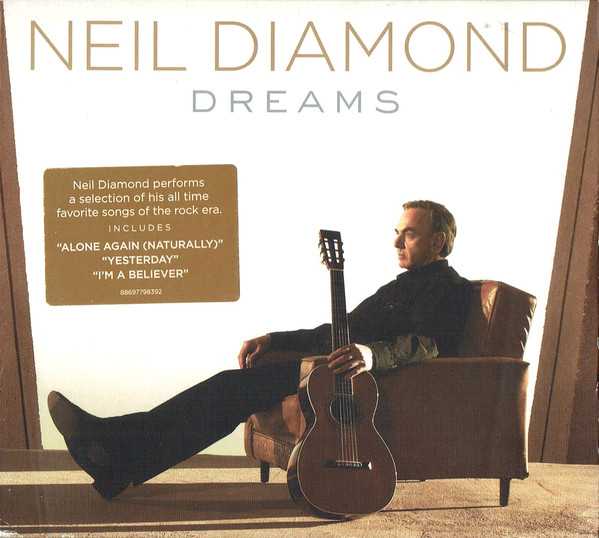 | Album: 45 of 48 Title: Dreams Released: 2010-11-01 Tracks: 14 Duration: 55:05 Scroll: Up Down Top Bottom 25% 50% 75% Spotify Allmusic AlbumCover | 1 Aint No Sunshine (03:37) 2 Blackbird (03:22) 3 Alone Again (Naturally) (03:57) 4 Feels Like Home (04:51) 5 Midnight Train to Georgia (05:00) 6 Im a Believer (04:27) 7 Love Song (03:57) 8 Losing You (03:16) 9 Hallelujah (04:10) 10 A Song for You (04:31) 11 Yesterday (03:31) 12 Let It Be Me (03:19) 13 Desperado (03:36) 14 Dont Forget Me (03:23) |
| Dreams : Allmusic album Review : After two excellent collaborations with Rick Rubin, Neil Diamond cant resist taking the production reins himself for this collection of (mostly) covers. His liner notes claim these songs as some of his favorites from the "rock era" -- implying its over. While this set is more intimate than most of his overblown production of the last 30 years, it is a step away from the simplicity of his work with Rubin, featuring full strings, chamber reeds, winds, and brass on various cuts. As a vocalist, Diamonds dramatic -- rather than involved -- authority is his trademark; he imposes it on almost every track. It works well here -- sometimes: the reading of Bill Withers "Aint No Sunshine" is excellent for this reason, more like a playwrights look than a lovers. The fiddle in Lennon and McCartneys "Blackbird" adds warmth to Diamonds declamatory vocal. Randy Newmans "Feels Like Home" is a set high point: it so intimate, naked, and desperate -- uncharacteristic of the ultra-private Diamond -- it can stop the listener in her tracks; it feels unintentionally included on this collection. The restrained narrative storytellers presentation of "Midnight Train to Georgia" is, despite its simple delivery, more empathic than passionate. The reading of Leonard Cohens transcendent "Hallelujah" is not definitive by any means, but it best illustrates Diamonds intention to pay homage to the song -- its an excellent version to add to the bunch that already exists. Lesley Duncans "Love Song" (Elton Johns reading on Tumbleweed Connection is the classic) is quietly yet exotically treated with layered acoustic guitars, a spare piano, and King Errissons imaginative hand percussion. Harry Nilssons "Dont Forget Me," which bookends the album, is another high point with a celebratory horn chart underscoring the romantic world-weary irony in Diamonds delivery. Some tracks just dont work. Gilbert OSullivans "Alone Again (Naturally)" sounds like the maudlin, trite novelty it is. Diamonds "Im a Believer" is rendered with far more drama than necessary. Here its not an iconic pop song. It comes from the back end of the story -- illustrated by acoustic guitars, cello, and vibraphone, its joy is displaced by resolve, as if the singer is trying to convince himself the songs lyrics are true. Like most covers sets, this is a mixed bag, and its for the hardcore Diamond fan more than those who admire Home Before Dark, 12 Songs, or his work from the 60s through the mid-70s. | ||
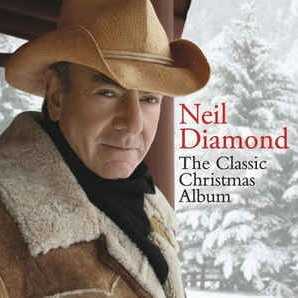 | Album: 46 of 48 Title: The Classic Christmas Album Released: 2013 Tracks: 12 Duration: 42:27 Scroll: Up Down Top Bottom 25% 50% 75% Spotify Allmusic AlbumCover | 1 White Christmas (03:55) 2 Joy to the World (02:40) 3 O Come All Ye Faithful (04:15) 4 The First Noel (03:34) 5 Winter Wonderland (02:44) 6 You Make It Feel Like Christmas (03:37) 7 The Christmas Song (03:33) 8 O Holy Night (03:28) 9 Silver Bells (03:06) 10 Sleigh Ride (02:43) 11 Have Yourself a Merry Little Christmas (04:44) 12 Silent Night (04:03) |
| The Classic Christmas Album : Allmusic album Review : Part of Legacys budget-priced Classic Christmas series, the Neil Diamond installment offers up 12 previously issued holiday hits, including yuletide classics like "Have Yourself a Merry Little Christmas," "The First Noel," "Winter Wonderland," "O Come All Ye Faithful," and "Silent Night." | ||
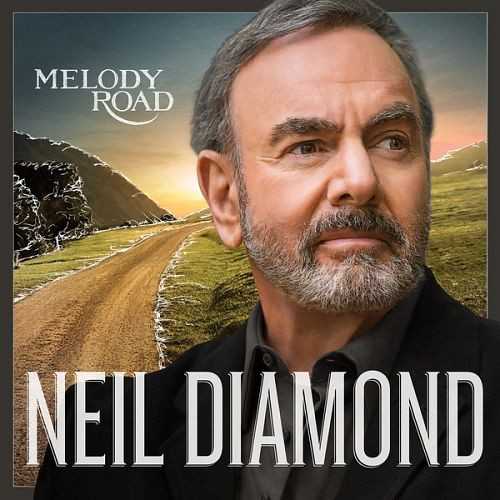 | Album: 47 of 48 Title: Melody Road Released: 2014-09-08 Tracks: 12 Duration: 46:20 Scroll: Up Down Top Bottom 25% 50% 75% Spotify Allmusic AlbumCover | 1 Melody Road (03:12) 2 First Time (04:02) 3 Seongah and Jimmy (05:44) 4 Something Blue (04:03) 5 Nothing but a Heartache (04:33) 6 In Better Days (03:30) 7 (Ooo) Do I Wanna Be Yours (06:14) 8 Alone at the Ball (02:56) 9 Sunny Disposition (03:14) 10 Marry Me Now (03:35) 11 The Art of Love (04:07) 12 Melody Road (reprise) (01:10) |
| Melody Road : Allmusic album Review : Leaving behind Columbia Records along with his latter-day collaborator producer Rick Rubin, Neil Diamond sets up shop at Capitol -- which now belongs to Universal Records, who owns his classic recordings for Uni and MCA -- and teams with producer Don Was for 2014s Melody Road. Diamond may have left his label of 40 years, but in an odd way, Melody Road is a return home after his stark wanderings of the 2000s. Rubin encouraged Diamond to be spare, sometimes recording him with little more than an acoustic guitar, but Was -- who is assisted by Jacknife Lee -- coaxes the singer/songwriter to bring back the schmaltz, an essential element of Neils glory days that was largely ignored on the Rubin records. Was and Lee retain a hint of that new millennial intimacy -- its never once as overblown as his 70s records -- but the songs themselves alternate between stately ballads, effervescent bubblegum, and self-important pomp. As on his best 70s records, which Melody Road often resembles in both construction and consistency, Diamond is best when he keeps his ambitions relatively simple. Theres majesty on the title track and haunting splendor on "Alone at the Ball," and they find their counterparts in the joyous "Something Blue" and "Marry Me Now," along with the spirited ramble of "First Time." Each of these songs evoke memories of Diamonds peak -- a little bit of "Solitary Man," a little bit of "I Am…I Said," a little bit of "Cherry Cherry" -- while the tedious socially aware slog of "Seongah and Jimmy" and endless ballad "(OOO) Do I Wanna Be Yours" bring back the Diamond thats often forgotten, the Diamond whose LPs often got bogged down in middlebrow aspirations. As much as these weigh down Melody Road, its also true that theres never been a Neil Diamond record where he doesnt stray into this murky territory. What makes a difference here is the general lightness of his new songs and Was and Lees sympathetic production; the two play off each other perfectly, turning this into the first latter-day Diamond record to feel quintessentially Neil Diamond. | ||
 | Album: 48 of 48 Title: Acoustic Christmas Released: 2016-10-28 Tracks: 10 Duration: 37:30 Scroll: Up Down Top Bottom 25% 50% 75% Spotify Allmusic AlbumCover | 1 O Holy Night (03:44) 2 Do You Hear What I Hear (04:03) 3 Christmas Prayers (04:30) 4 Hark the Herald Angels Sing (04:13) 5 Mary’s Boy Child (03:19) 6 Silent Night (03:41) 7 Go Tell It on the Mountain (03:16) 8 Children Go Where I Send Thee (05:25) 9 Christmas in Killarney (02:03) 10 Christmas Medley: Almost Day / Make a Happy Song / We Wish You a Merry Christmas (03:12) |
| Acoustic Christmas : Allmusic album Review : Re-teaming with Don Was and Jacknife Lee, the pair who produced his 2014 album Melody Road, Neil Diamond cut Acoustic Christmas, his fourth holiday album and first since 2009s A Cherry Cherry Christmas. The title Acoustic Christmas suggests that this 2016 LP will be sparse, but its hazy and open, consisting of much more than a man and a guitar. Usually hes supported by a full band -- a rhythm section, another guitarist, a keyboardist, and backing vocalists -- and that gives Acoustic Christmas some spunk, which is enough to keep things lively. If Diamond isnt always original -- his version of "Children Go Where I Send Thee" follows the contours of Nick Lowes 2013 version exactly -- he nevertheless performs with gusto, particularly on the closing "Christmas Medley." That showmanship is ultimately what gives Acoustic Christmas its personality and is the reason to return to the record: it may not align with the spirit of the season, but its charming nonetheless. | ||